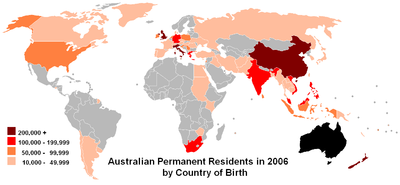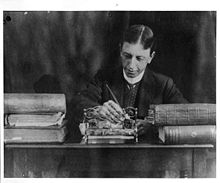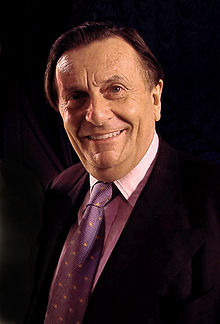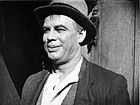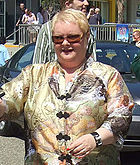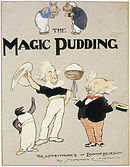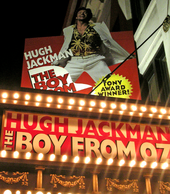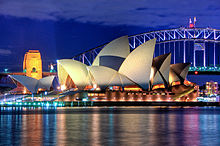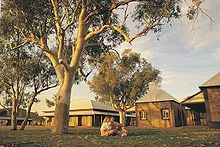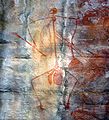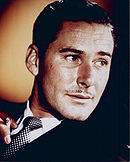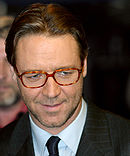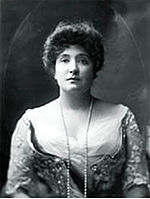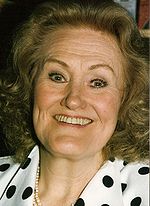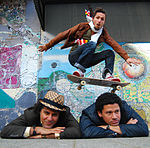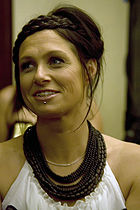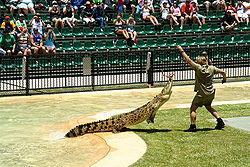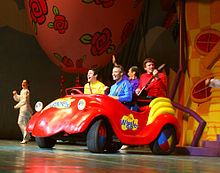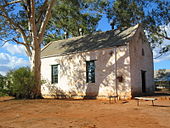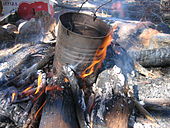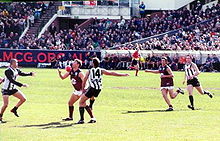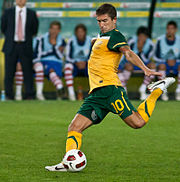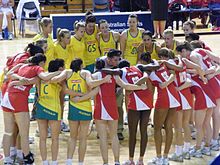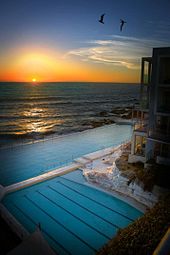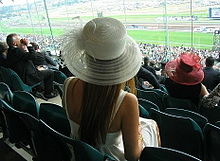- Culture of Australia
-
Culture of Australia 








From top left: Didgeridoo player; cricketer Don Bradman; Sunbaker by Max Dupain; A digger on Anzac Day; opera singer Dame Joan Sutherland; satirist Barry Humphries; actress Nicole Kidman; comedian Anh Do; rock band INXS; the chamber of the Australian House of Representatives The culture of Australia is essentially a Western culture influenced by the unique geography of the Australian continent and by the diverse input of Aboriginal and Torres Strait Islander peoples, and various waves of multi-ethnic migration which followed the British colonisation of Australia.[1] The predominance of the English language, the existence of a democratic Westminster system of government, Christianity as the dominant religion and the popularity of sports such as cricket and rugby evidence a significant Anglo-Celtic heritage, but Australia today hosts a great diversity of cultural practices and pursuits.
Aboriginal people are believed to have arrived as early as 60,000 years ago, and evidence of Aboriginal art in Australia dates back at least 30,000 years. Several states and territories had their origins as penal colonies, with the First Fleet of British convicts arriving at Sydney Cove in 1788. Stories of outlaws like the bushranger Ned Kelly have endured in Australian music, cinema and literature. The Australian gold rushes from the 1850s brought wealth as well as new social tensions to Australia, including the miners' Eureka Stockade rebellion. The colonies established elected parliaments and rights for workers and women in advance of most other Western nations.[2] Federation in 1901 evidenced a growing sense of national identity - with the Heidelberg School painters and writers like Banjo Paterson, Henry Lawson and Dorothea McKellar. The World Wars profoundly altered Australia's sense of identity - with World War I introducing ANZAC, and World War II seeing a reorientation from Britain to the United States as a major ally. After the second war, 6.5 million migrants from 200 nations brought immense new diversity, and Australians grew increasingly aware of proximity to Asia.
Egalitarianism, informality and an irreverent sense of humour have been common themes of cultural commentary - exemplified by the works of C J Dennis, Barry Humphries and Paul Hogan.[3] Fascination with the outback has persisted in the arts in Australia and agriculture has been an important economic sector, but the demographics of Australia show it to be one of the most urbanised populations in the world, with more than 75 per cent of people living an urban lifestyle, largely in the capital cities along the coast. These comprise the melting pots of what has become known since the 1970s as multicultural Australia.
The capital cities host such internationally renowned cultural institutions as the Sydney Opera House and National Gallery of Victoria, and Australia has contributed many artists to international pop and classical culture, from hard rock's AC/DC to opera's Joan Sutherland. Australians also support or participate enthusiastically in a wide variety of sports, including Australian Rules Football and a vibrant surf culture.
From Indigenous Australia to multicultural Australia
The oldest surviving cultural traditions in Australia – and some of the oldest surviving cultural traditions on earth – are those of Australia's Aboriginal and Torres Strait Islander peoples. Their ancestors have inhabited Australia for between 40,000 and 60,000 years, living a hunter-gatherer lifestyle until the arrival of Europeans began to alter their patterns of living. Today, the Indigenous population is estimated at around 2.3 per cent of the total population - approximately 483,000 people. The traditional belief system of Australia's aborigines is known as The Dreamtime. Conflict and reconciliation between indigenous and non-indigenous Australians has been a source of much art and literature in Australia, and ancient Aboriginal artistic styles and iconic inventions such as the boomerang, the didgeridoo and Indigenous Australian music have become symbols of modern Australia.
 South Australian suffragette Catherine Helen Spence (1825-1910). The Australian colonies established democratic parliaments from the 1850s and began to grant women the vote in the 1890s.
South Australian suffragette Catherine Helen Spence (1825-1910). The Australian colonies established democratic parliaments from the 1850s and began to grant women the vote in the 1890s.
The arrival of Europeans from 1788 onward profoundly disrupted Aboriginal life. According to the historian Geoffrey Blainey, during the colonial period: "In a thousand isolated places there were occasional shootings and spearings. Even worse, smallpox, measles, influenza and other new diseases swept from one Aboriginal camp to another ... The main conqueror of Aborigines was to be disease and its ally, demoralisation."[2]
The rest of Australia is descended from the more recent migrants who have arrived from around 200 countries since the First Fleet of British convicts arrived to establish the first European settlement at Sydney in 1788. The British Empire expanded across the whole continent and established six colonies. South Australia established itself as a "free colony" with no convicts and a vision for a territory with political and religious freedoms, together with opportunities for wealth through business and pastoral investments.[4] William Wentworth established Australia's first political party in 1835 to demand democratic government for New South Wales. From the 1850s, the colonies set about writing constitutions which produced democratically progressive parliaments as Constitutional Monarchies with the British monarch as the symbolic head of state.[5] Women's suffrage in Australia was achieved from the 1890s.[6] Women became eligible to vote in South Australia in 1895. This was the first legislation in the world permitting women to stand for political office and, in 1897, Catherine Helen Spence became the first female political candidate.[7][8] Though constantly evolving, the key foundations for elected parliamentary government have maintained an historical continuity in Australia from the 1850s into the 21st century.
The Commonwealth of Australia was founded by a series of referendums conducted in the British colonies of Australasia (although Fiji and New Zealand subsequently dropped out of the process)[9] under the Australian Constitution in 1901, which established a federal democracy and enshrined human rights such as sections 41 (right to vote), 80 (right to trial by jury), 116 (freedom of religion) as foundational principles of Australian law and included economic rights such as restricting the government to acquiring property only "on just terms".[10] The Australian Labor Party was established in the 1890s and the Liberal Party of Australia in 1944, both rising to be the dominant political parties and rivals of Australian politics, though various other parties have been and remain influential. Voting is compulsory in Australia and government is essentially formed by a group commanding a majority of seats in the Australian House of Representatives selecting a leader who becomes Prime Minister. Australia remains a constitutional monarchy in which the largely ceremonial and procedural duties of the monarch are performed by a Governor General selected by the Australian government.
The colonies experienced a taste of multi-ethnic immigration during the Australian gold rushes, but following Federation in 1901, the Parliament instigated the White Australia Policy that gave preference to British migrants and ensured that Australia remained a predominantly Anglo-Celtic society until well into the 20th Century. The post-World War II immigration program saw the policy dismantled by successive governments, permitting large numbers of Southern European, and later Asian and Middle Eastern migrants to arrive. The Menzies Government (1949-1966) and Holt Government dismantled the legal barriers to multi-ethnic immigration and by the 1970s, the Whitlam and Fraser Governments were promoting multiculturalism.[11]
Countries of birth of Australian estimated resident population, 2006. Click image to enlarge.
Source:Australian Bureau of Statistics[12]Some States and Territories of Australia retained discriminatory laws relating to voting rights for Indigenous Australians into the 1960s, at which point full legal equality was established. A 1967 referendum to include all Aborigines in the national electoral roll census was overwhelmingly approved by voters. In the mid 1960s, Charles Perkins of the University of Sydney, helped organise freedom rides to expose discrimination in rural communities. In 1966, the Gurindji strike was led by Vincent Lingiari in a quest for equal pay and recognition of land rights at a cattle station.[13] In 1971, Liberal Senator Neville Bonner became the first Aboriginal in the Federal Parliament. Sir Douglas Nicholls, who had been a leading Aboriginal rights activist since the 1930s, was appointed Governor of South Australia in 1976.[14] In 1984, a group of Pintupi people who were living a traditional hunter-gatherer desert-dwelling life were tracked down in the Gibson Desert and brought in to a settlement. They are believed to have been the last uncontacted tribe.[15] In the early 21st century, much of indigenous Australia continued to suffer lower standards of health and education than non-indigenous Australia.
Australia's contemporary immigration program has two components: a program for skilled and family migrants and a humanitarian program for refugees and asylum seekers.[16] By 2010, the post-war immigration program had received more than 6.5 million migrants from every continent. The population tripled in the six decades to around 21 million in 2010, comprising people originating from 200 countries.[17] More than 43 per cent of Australians were either born overseas or have one parent who was born overseas. The population is highly urbanised, with more than 75% of Australians live in urban centres, largely along the coast.[3]
Contemporary Australia is a pluralistic society, rooted in liberal democratic traditions - in which tolerance, informality and egalitarianism are seen as key societal values. Heavily influenced by Anglo-Celtic origins the culture of Australia has also been shaped by multi-ethnic migration which has influenced all aspects of Australian life, including business, the arts, cooking, sense of humour and sporting tastes.[3]
National symbols
When the Australian colonies federated on 1 January 1901, an official competition for a design for an Australian flag was held. The final design which was adopted contains the Union Flag in the left corner symbolising Australia's historical links to the United Kingdom, the stars of the Southern Cross on the right half of the flag indicating Australia's geographical location and the seven pointed Federation Star in the bottom left representing the six states and the territories of Australia. Other official flags include[18] the Australian Aboriginal flag, the Torres Strait Islander flag and the flags of the individual states and territories.
Green and gold were confirmed as Australia's national colours by the governor general in 1984, though the colours had been adopted by many national sporting teams long before this. The golden wattle was officially proclaimed as the national floral emblem in 1988. The Australian Coat of Arms was granted by King George V in 1912 and consists of a shield containing the badges of the six states, within an ermine border. The crest above the shield and helmet is a seven-pointed gold star on a blue and gold wreath, representing the 6 states and the territories. The shield is supported by a red kangaroo and an emu. A revised version of the 19th century song ‘Advance Australia Fair’ became Australia’s official national anthem in 1984.[19]
Royal symbols
Reflecting the country's status as a constitutional monarchy, a number of royal symbols exist in Australia. These include symbols of the monarch of Australia, as well as the monarch's Vice-regal representatives.
Despite the fact that the Queen of Australia is not resident in Australia itself, the Crown remains a visible part of the everyday lives of Australians. The birthday of the monarch is celebrated as a public holiday across all states and territories, although the dates vary. The Australian currency, including all coins and the five dollar note, bear an image of the reigning monarch, Queen Elizabeth II. Around 12% of public lands in Australia are referred to as Crown land, including reserves set aside for environmental conservation as well as vacant land. There are many geographic places that have been named in honour of a reigning monarch, including the states of Queensland and Victoria, named after Queen Victoria, with numerous streets, squares, parks and buildings carrying the names of past or present members of the Royal Family. Through royal patronage there are many organisations in Australia that have been granted a Royal prefix. These organisations, including branches of the Australian Defence Force, often incorporate royal symbols into their imagery.
Language
Further information: Languages of Australia, Australian slang, Indigenous Australian languages, and Regional variation in Australian EnglishAlthough Australia has no official language, it is largely monolingual with English being the "de facto" national language. Australian English generally follows the Queen's English spelling and grammar norms, but has its own distinctive accent and vocabulary – including the distinctive "g'day", a common and renowned greeting used in Australia. According to the 2001 census, English is the only language spoken in the home for around 80% of the population. The next most common languages spoken at home are Chinese (2.1%), Italian (1.9%), and Greek (1.4%). A considerable proportion of first- and second-generation migrants are bilingual. Australia has a sign language known as Auslan, which is the main language of about 6,500 deaf people.
It is believed that there were between 200 and 300 Australian Aboriginal languages at the time of first European contact, but only about 70 of these languages have survived and all but 20 of these are now endangered. An indigenous language is the main language for about 50,000 people (0.25% of the population).[20]
Humour
Main article: Australian comedyComedy is an important part of the Australian identity. The "Australian sense of humour" is often characterised as dry, irreverent and ironic, exemplified by the works of performing artists like Barry Humphries and Paul Hogan.[21] The quirks of Australian multiculturalism have also provided fodder for comedy.
The convicts of the early colonial period helped establish anti-authoritarianism as a hallmark of Australian comedy. Influential in the establishment of stoic, dry wit as a characteristic of Australian humour were the bush balladeers of the 19th century, including Henry Lawson, author of The Loaded Dog.[22] His contemporary, Banjo Paterson, contributed a number of classic comic poems. CJ Dennis wrote humour in the Australian vernacular - notably in "The Songs of a Sentimental Bloke". The Dad and Dave series about a farming family was an enduring hit of the early 20th century. The World War I ANZAC troops were said to often display irreverence in their relations with superior officers and dark humour in the face of battle.[23]
Australian comedy has a strong tradition of self-mockery, from the outlandish Barry McKenzie expat-in-Europe movies of the 1970s, to the quirky outback characters of the Crocodile Dundee films of the 1980s, the suburban parody of Working Dog Productions' 1997 film The Castle and the dysfunctional suburban mother-daughter sitcom Kath & Kim. In the 1970s, satirical talk-show host Norman Gunston (played by Garry McDonald), with his malapropisms, sweep-over hair and poorly shaven face, rose to great popularity by pioneering the satirical "ambush" interview technique (later employed by Britain's Sacha Baron Cohen as Ali G) and giving unique interpretations of pop songs. Roy and HG provide an affectionate but irreverent parody of Australia's obsession with sport. The Dream with Roy and HG has been a regular feature of Olympic television coverage since the 2000 Sydney Olympics.
Since the 1950s, the satirical character creations of Barry Humphries have included housewife "gigastar" Edna Everage and "Australian cultural attaché" Les Patterson, whose interests include boozing, chasing women and flatulence.[24] For his delivery of dadaist and absurdist humour to millions, biographer Anne Pender described Humphries in 2010 as "the most significant comedian to emerge since Charlie Chaplin".[25]
The vaudeville talents of Graham Kennedy, Don Lane and Bert Newton earned popular success during the early years of Australian television. The variety show Hey Hey It's Saturday screened for three decades. Among the best loved Australian sitcoms was Mother and Son, about a divorcee who had moved back into the suburban home of his mother - but sketch comedy has been the stalwart of Australian television. The Comedy Company, in the 1980s, featured the comic talents of Mary-Anne Fahey, Ian McFadyen, Mark Mitchell, Glenn Robbins, Kym Gyngell and others. Growing out of Melbourne University and The D-Generation came The Late Show (1991–1993), starring the influential talents Santo Cilauro, Tom Gleisner, Jane Kennedy, Tony Martin, Mick Molloy and Rob Sitch (who later formed Working Dog Productions); and during the 1980s and 1990s Fast Forward (Steve Vizard, Magda Szubanski, Marg Downey, Michael Veitch, Peter Moon and others) and its successor Full Frontal, which launched the career of Eric Bana and featured Shaun Micallef.
The perceptive wit of Clive James and Andrew Denton has been popular in the talk-show interview style. Representatives of the "bawdy" strain of Australian comedy include Rodney Rude, Austen Tayshus and Chad Morgan. Quintessential Australian country music hits included the novelty songs A Pub with No Beer (1957) by Slim Dusty and Tie Me Kangaroo Down Sport (1960s) by Rolf Harris which help define a comic tradition of Australian music.
Cynical satire has had enduring popularity, with television series such as Frontline, targeting the inner workings of "news and current affairs" TV journalism, The Hollowmen (2008), set in the office of the Prime Minister's political advisory (spin) department, and The Chaser series, which cynically examines domestic and international politics.[21] Actor/writer Chris Lilley has produced a series of award winning "mockumentary" style television series about Australian characters since 2005.
Post-war immigration has seen migrant humour flourish: from They're a Weird Mob (1966) about an Italian immigrant adapting to Sydney life, to the works of Vietnamese refugee Anh Do, Egyptian stand-up comic Akmal Saleh and Nick Giannopoulos' Wog Boy 2: Kings of Mykonos (2010) about second generation Australian Greeks returning to their ancestral home.
The annual Melbourne International Comedy Festival is one of the largest comedy festivals in the world, and a popular fixture on the city's cultural calendar.[26]
Australian tastes can be eclectic when it comes to imported comedy from other English speaking countries, with American series like M*A*S*H, Seinfeld, and The Simpsons acquiring devoted followings in Australia - but so too such quintessentially British comedies as Fawlty Towers, The Goodies, Blackadder and The Office.[27]
Arts in Australia
Arts in Australia Culture of Australia Architecture
Art
Cinema
Comic books
Cuisine
Dance
Literature
Music
Television
Theatre
HumourThe arts in Australia—film, music, painting, theatre, dance and crafts—have achieved international recognition. While much of Australia's cultural output has traditionally tended to fit with general trends and styles in Western arts, the arts as practiced by indigenous Australians represent a unique Australian cultural tradition, and Australia's landscape and history have contributed to some unique variations in the styles inherited by Australia's various migrant communities.[28][29][30]
At the close of the 19th century, the art of the Heidelberg School began to capture the unique colours of the Australian bush, famed writers Henry Lawson and Banjo Paterson presented conflicting views of the harshness and romance of life in Australia, and performing artists like Dame Nellie Melba succeeded internationally in the traditional European arts. During the 20th century, writers and performers like C J Dennis, Barry Humphries and Paul Hogan both mocked and celebrated Australian cultural stereotypes, while shifting demographics saw a diversification of artistic output, with writers like feminist Germaine Greer challenging traditional cultural norms.
Australia's capital cities each support traditional "high culture" institutions in the form of major art galleries, ballet troupes, theatres, symphony orchestras, opera houses and dance companies. Leading Australian performers in these fields have included the opera Dames Nellie Melba and Joan Sutherland, dancers Edouard Borovansky and Sir Robert Helpmann, and choreographer/dancers such as Graeme Murphy and Meryl Tankard. Opera Australia is based in Sydney at the world renowned Sydney Opera House.[31] The Australian Ballet, Melbourne and Sydney symphony orchestras are also well regarded cultural institutions.
Organisations such as the Sydney Theatre Company and National Institute of Dramatic Art have fostered students of theatre, film, and television several of whom have continued to international success, with actors like Cate Blanchett and Geoffrey Rush having been associated with both institutions.
Independent culture thrives in all capital cities and exists in most large regional towns. The independent arts of music, film, art and street art are the most extensive. Melbourne's independent music scene, is one of the largest in the world, whilst another can be found in the multitude of international street artists visiting Melbourne and, to a lesser extent, other major cities, to work for a period of time.
Literature
Australian writers who have obtained international renown include the Nobel winning author Patrick White, as well as authors Peter Carey, Thomas Keneally, Colleen McCullough, Nevil Shute and Morris West. Notable contemporary expatriate authors include the feminist Germaine Greer, art historian Robert Hughes and humorists Barry Humphries and Clive James.[32]
Among the important authors of classic Australian works are the poets Henry Lawson, Banjo Paterson, C J Dennis and Dorothea McKellar. Dennis wrote in the Australian vernacular with such works as The Sentimental Bloke, while McKellar wrote the iconic patriotic poem My Country which rejected prevailing fondness for England's "green and shaded lanes" and declared: "I love a sunburnt country". At one point, Lawson and Paterson contributed a series of verses to The Bulletin magazine in which they engaged in a literary debate about the nature of life in Australia. Lawson said Paterson was a romantic and Paterson said Lawson was full of doom and gloom.[33] Lawson is widely regarded as one of Australia's greatest writers of short stories, while Paterson's poems The Man From Snowy River and Clancy of the Overflow remain amongst the most popular Australian bush poems. Significant political poets of the 20th century included Dame Mary Gilmore and Judith Wright. Among the best known contemporary poets are Les Murray and Bruce Dawe.
Novelists of classic Australian works include Marcus Clarke (For the Term of His Natural Life), Rolf Boldrewood (Robbery Under Arms), Miles Franklin (My Brilliant Career), Mary Durack (Kings in Grass Castles and Keep Him My Country) and Jeannie Gunn (We of the Never Never). Franklin, Durack and Gunn are notable for their accounts of Outback living from a female perspective. Ruth Park, author of The Harp in the South, contributed a number of iconic fictional works about urban living.
In terms of children's literature, Norman Lindsay (The Magic Pudding) and May Gibbs (Snugglepot and Cuddlepie) are among the Australian classics.
The extraordinary circumstances of the convict foundations of Australian theatre are recounted in Thomas Keneally's novel The Playmaker. Eminent writers of Australian plays have included Steele Rudd (On Our Selection), David Williamson, Alan Seymour and Nick Enright.
Although historically only a small proportion of Australia's population have lived outside the major cities, many of Australia's most distinctive stories and legends originate in the outback, in the drovers and squatters and people of the barren, dusty plains.[34]
David Unaipon is known as the first indigenous author. Oodgeroo Noonuccal was the first Aboriginal Australian to publish a book of verse.[35] A significant contemporary account of the experiences of Indigenous Australia can be found in Sally Morgan's My Place. Contemporary academics and activists including Marcia Langton and Noel Pearson are prominent essayists and authors on Aboriginal issues.
Charles Bean (The Story of Anzac: From the Outbreak of War to the End of the First Phase of the Gallipoli Campaign 4 May 1915, 1921) Geoffrey Blainey (The Tyranny of Distance, 1966), Robert Hughes (The Fatal Shore, 1987), Manning Clark (A History of Australia, 1962–87), and Marcia Langton (First Australians, 2008) are authors of important Australian histories.
Theatre
 Dame Edna Everage, a comic creation of Barry Humphries, debuted in Melbourne in the 1950s and has featured at the West End and Broadway.
Dame Edna Everage, a comic creation of Barry Humphries, debuted in Melbourne in the 1950s and has featured at the West End and Broadway.
The ceremonial dances of indigenous Australians which recount the stories of the Dreamtime, comprise theatrical aspects and have been performed since time immemorial[quantify].[36] European traditions came to Australia with the First Fleet in 1788, with the first production being performed in 1789 by convicts.[37] Two centuries later, the extraordinary circumstances of the foundations of Australian theatre were recounted in Our Country's Good by Timberlake Wertenbaker: the participants were prisoners watched by sadistic guards and the leading lady was under threat of the death penalty.[37]
The Theatre Royal, Hobart, opened in 1837 and it remains the oldest theatre in Australia.[38] The Australian gold rushes beginning in the 1850s provided funds for the construction of grand theatres in the Victorian style. A theatre was built on the present site of Melbourne's Princess Theatre in 1854. The present building now hosts major international productions as well as live performance events such as the Melbourne International Comedy Festival.[39]
The Melbourne Athenaeum was built during this period and later became Australia's first cinema, screening The Story of the Kelly Gang, the world's first feature film in 1906. Mark Twain, Nellie Melba, Lawrence Olivier and Barry Humphries have all performed on this historic stage.[40] The Queen's Theatre, Adelaide opened with Shakespeare in 1841 and is today the oldest theatre on the mainland.[41]
After Federation in 1901, theatre productions evidenced the new sense of national identity. On Our Selection (1912) by Steele Rudd, told of the adventures of a pioneer farming family and became immensely popular. Sydney's grand Capitol Theatre opened in 1928 and after restoration remains one of the nation's finest auditoriums.[42]
In 1955, Summer of the Seventeenth Doll by Ray Lawler portrayed resolutely Australian characters and went on to international acclaim. That same year, young Melbourne artist Barry Humphries performed as Edna Everage for the first time at Melbourne University's Union Theatre. Humphries left for London in his early 20s and enjoyed success on stage, including in Lionel Bart's musical, Oliver!. His satirical stage creations - notably Dame Edna and later Les Patterson - became Australian cultural icons. Humphries also achieved success in the USA with tours on Broadway and television appearances and has been honoured in Australia and Britain.[43]
The National Institute of Dramatic Art was created in Sydney in 1958. This institute has since produced a list of famous alumni including Cate Blanchett, Mel Gibson and Baz Luhrmann.[44]
Construction of the Adelaide Festival Centre began in 1970 and South Australia's Sir Robert Helpmann became director of the Adelaide Festival of Arts.[45][46] The new wave[clarification needed] of Australian theatre debuted in the 1970s. The Belvoir St Theatre presented works by Nick Enright and David Williamson. In 1973, the Sydney Opera House was inaugurated in Sydney - becoming perhaps[weasel words] the most famous theatre building in the world.[citation needed] Opera Australia made its home in the building and its reputation was enhanced by the presence of the diva Joan Sutherland.
The Sydney Theatre Company was founded 1978 becoming one of Australia's foremost theatre companies.[47] The Bell Shakespeare Company was created in 1990. A period of success for Australian musical theatre came in the 1990s with the debut of musical biographies of Australian music singers Peter Allen (The Boy From Oz in 1998) and Johnny O'Keefe (Shout! The Legend of The Wild One).
In The One Day of the Year, Alan Seymour studied the paradoxical nature of the ANZAC Day commemoration by Australians of the defeat of the Battle of Gallipoli. Ngapartji Ngapartji, by Scott Rankin and Trevor Jamieson, recounts the story of the effects on the Pitjantjatjara people of nuclear testing in the Western Desert during the Cold War. It is an example of the contemporary fusion of traditions of drama in Australia with Pitjantjatjara actors being supported by a multicultural cast of Greek, Afghan, Japanese and New Zealand heritage.[48]
Architecture
Australia has three architectural listings on UNESCO's World Heritage list: Australian Convict Sites (comprising a collection of separate sites around Australia, including Hyde Park Barracks in Sydney, Port Arthur in Tasmania, and Fremantle Prison in Western Australia); the Sydney Opera House; and the Royal Exhibition Building in Melbourne. Contemporary Australian architecture includes a number of other iconic structures, including the Harbour Bridge in Sydney and Parliament House, Canberra. Significant architects who have worked in Australia include Governor Lachlan Macquarie's colonial architect, Francis Greenway; the ecclesiastical architect William Wardell; the designer of Canberra's layout, Walter Burley Griffin; the modernist Harry Seidler; and Jørn Utzon, designer of the Sydney Opera House. The National Trust of Australia is a non-governmental organisation charged with protecting Australia's built heritage.
Evidence of permanent structures built by indigenous Australians before European settlement of Australia in 1788 is limited. Much of what they built was temporary, and was used for housing and other needs. As a British colony, the first European buildings were derivative of the European fashions of the time. Tents and wattle and daub huts preceded more substantial structures. Georgian architecture is seen in early government buildings of Sydney and Tasmania and the homes of the wealthy. While the major Australian cities enjoyed the boom of the Victorian Era, the Australian gold rushes of the mid-19th century brought major construction works and exuberant Victorian architecture to the major cities, particularly Melbourne, and major provincials such as Ballarat and Bendigo. Other significant architectural movements in Australian architecture include the Federation style of the turn of the 20th century and the modern styles of the late 20th century which also saw many older buildings demolished. The Queenslander is a term which denotes the primarily residential style of warm climate architecture developed in Queensland and northern parts of New South Wales.
Religious architecture is also prominent throughout Australia, with large Anglican or Catholic cathedrals in every major city and Christian churches in most towns. Notable examples include St Patrick's Cathedral, Melbourne and St Mary's Cathedral, Sydney. Other houses of worship are also common, reflecting the cultural diversity existing in Australia; the oldest Islamic structure in the southern hemisphere is the Central Adelaide Mosque (built in the 1880s),[49] and one of the largest Buddhist Temples in the southern hemisphere is Wollongong's Nan Tien Temple.[50] Sydney's gothic design Great Synagogue was consecrated in 1878.[51]
Historically, Australian pubs have also been noted for often distinctive designs.
Significant concern was raised during the 1960s, with developers threatening the destruction of historical buildings, especially in Sydney. Heritage concerns led to union-initiated green bans, which saved significant examples of Australia's architectural past. Green bans helped to protect historic 18th century buildings in The Rocks from being demolished to make way for office towers, and prevented the Royal Botanic Gardens from being turned into a car park for the Sydney Opera House.
-
The UNESCO listed Hyde Park Barracks, Sydney.
-
UNESCO listed convict era architecture at Port Arthur, Tasmania
-
Interior of St Mary's Cathedral, Sydney.
-
The UNESCO listed Royal Exhibition Building, Melbourne
-
The iconic Birdsville Hotel, an Australian pub in Queensland
-
Charlotte Pass alpine village in the Snowy Mountains of New South Wales
-
Modern coastal highrise, Gold Coast, Queensland.
-
A typical Queenslander house in New Farm, Queensland. A unique regional style influenced by location and climate.
Painting and sculpture
Main article: Visual arts of AustraliaThe visual arts have a long history in Australia and examples of ancient Aboriginal rock artworks can be found throughout the continent - notably in national parks such as those of the UNESCO listed sites at Uluru and Kakadu National Park in the Northern Territory, but also within protected parks in urban areas such as at Ku-ring-gai Chase National Park in Sydney.[52][53][54] Evidence of Aboriginal art can be dated back around 30,000 years.[55] Since the 1970s, indigenous artists have employed the use of acrylic paints - with styles such as that of the Western Desert Art Movement becoming globally renounced 20th century art movements.
Following the arrival of permanent European settlement in Australia in 1788, the story of early Australian painting has been described[by whom?] as requiring of artists a shift from a "European sense of light" to an "Australian sense of light". The origins of distinctly Australian painting is often associated with the Heidelberg School of the 1880s-1890s. Artists such as Arthur Streeton, Frederick McCubbin and Tom Roberts applied themselves to recreating in their art a truer sense of light and colour as seen in Australian landscape. Like the European Impressionists, they painted in the open air. These artists found inspiration in the unique light and colour which characterises the Australian bush.
Among the first Australians artists to gain a reputation overseas was the impressionist John Peter Russell during the 1880s. Another notable expatriate artist of the era was Rupert Bunny, a painter of landscape, allegory and sensual and intimate portraits.
Among the principle Australian artists of the 20th century are the surrealists Sidney Nolan, Arthur Boyd and Russell Drysdale, the avant-garde Brett Whiteley, the painter/sculptors William Dobell and Norman Lindsay, the landscapists Albert Namatjira and Lloyd Rees, the modernist photographer Max Dupain, and the Aboriginal artist Emily Kame Kngwarreye. Each has helped to define the unique character of the visual arts in Australia.[28]
The first Archibald Prize was awarded by the Art Gallery of New South Wales in 1921, to WB McInnes, for his portrait of Desbrowe Annear. This prize for portraiture of a man or woman "distinguished in the Arts, Letters, Science or Politics" has grown to be Australia's most popular and prestigious art award.[56]
Modernism arrived in Australia early in the 20th century. Among the earliest exponents were Grace Cossington Smith and Margaret Preston. Artists such as Pro Hart and Ken Done contributed to the development of modern, popular style of Australian art - as has painter and performing artist Rolf Harris.[57] Humorist Barry Humphries has been a provactive[clarification needed] exponent of Dadaism in Australia.[58] Michael Leunig has been an Australian artist who has developed renowned style of poetic cartoons.[59]
Australia has a number of notable museums and galleries, including the National Gallery of Victoria in Melbourne, the National Gallery of Australia, National Portrait Gallery of Australia and National Museum of Australia in Canberra, and the Art Gallery of New South Wales in Sydney.
-
Aboriginal Rock Art, Ubirr Art Site, Kakadu National Park
-
A holiday at Mentone 1888 by Charles Conder of the Heidelberg School
-
Down on His Luck 1889 by Frederick McCubbin of the Heidelberg School
-
Sunbaker (1937) an iconic photograph by Max Dupain
Cinema
Australia has a long history of film production. Australia's first dedicated film studio, the Limelight Department, was created by The Salvation Army in Melbourne in 1898, and is believed to have been the world's first.[60] The world's first feature-length film was the Australian production The Story of the Kelly Gang of 1906.[61] After such early successes, Australian cinema suffered from the rise of Hollywood.
In 1933, In the Wake of the Bounty was directed by Charles Chauvel, who cast Tasmanian born Erroll Flynn as the leading actor.[62] Flynn went on to a celebrated career in Hollywood. Chauvel directed a number of successful Australian films, the last being 1955's Jedda, which was notable for being the first Australian film to be shot in colour, and the first to feature Aboriginal actors in lead roles and to be entered at the Cannes Film Festival.[63] It was not until 2006 and Rolf De Heer's Ten Canoes that a major feature length drama was shot in an indigenous language.
The first Australian Oscar was won by 1942's Kokoda Front Line!, directed by Ken G. Hall.[64]
During the late 1960s and 1970s an influx of government funding saw the development of a new generation of film makers telling distinctively Australian stories, including directors Peter Weir, George Miller and Bruce Beresford. Films such as Picnic at Hanging Rock and Sunday Too Far Away had an immediate international impact. The 1980s is often regarded[by whom?] as a golden age of Australian cinema, with many successful films, from the historical drama of Gallipoli, to the dark science fiction of Mad Max, the romantic adventure of The Man From Snowy River or the comedy of Crocodile Dundee.[65]
A major theme of Australian cinema has been survival in the harsh Australian landscape. A number of thrillers and horror films dubbed "outback gothic" have been created, including Wake in Fright, Walkabout, The Cars That Ate Paris and Picnic at Hanging Rock in the 1970s, Razorback and Shame in the 1980s, and Japanese Story, The Proposition "Van Diemen's Land and the world-renowned Wolf Creek in the 21st century. These films depict the Australian bush and its creatures as deadly, and its people as outcasts and psychopaths. These concepts are combined with futuristic post-apocalyptic themes in the Mad Max series.
The 1990s saw a run of successful comedies such as Muriel's Wedding, The Castle and Strictly Ballroom, which helped launch the careers of Toni Collette, P. J. Hogan, Eric Bana and Baz Luhrmann. Australian humour features prominently in Australian film, with a strong tradition of self-mockery, from the Ozploitation style of the Barry McKenzie expat-in-Europe movies of the 1970s, to the quirky outback characters of the Crocodile Dundee films and the Working Dog Productions' 1997 homage to suburbia The Castle. Comedies like the barn yard animation Babe (1995), directed by Chris Noonan; Baz Lurhmann's Strictly Ballroom (1992); Rob Sitch's The Dish (2000); and Stephan Elliott's The Adventures of Priscilla, Queen of the Desert (1994) all feature in the top ten box-office list.[66]
During the 1990s, a new crop of Australian stars were successful in Hollywood, including Russel Crowe, Cate Blanchett and Heath Ledger who all rose to international prominence and critical acclaim.
The domestic film industry is also supported by US producers who produce in Australia following the decision by Fox head Rupert Murdoch to utilise new studios in Melbourne and Sydney where filming could be completed well below US costs. Notable productions include The Matrix, Star Wars episodes II and III, and Australia starring Nicole Kidman and Hugh Jackman.
Music
Indigenous music
 Geoffrey Gurrumul Yunupingu is a contemporary indigenous performer who sings in the Yolŋu Matha languages.
Geoffrey Gurrumul Yunupingu is a contemporary indigenous performer who sings in the Yolŋu Matha languages.
Aboriginal song was an integral part of Aboriginal culture. The most famous feature of their music is the didgeridoo. This wooden instrument, used amongst the Aboriginal tribes of northern Australia, makes a distinctive droning sound and its use has been adopted by a wide variety of non-Aboriginal performers.
Aboriginal musicians have turned their hand to Western popular musical forms, often to considerable commercial success. Pioneers included Lionel Rose, and Jimmy Little, while notable contemporary examples include Archie Roach, the Warumpi Band, NoKTuRNL and Yothu Yindi. Geoffrey Gurrumul Yunupingu (formerly of Yothu Yindi) has attained international success singing contemporary music in English and in the language of the Yolngu. Christine Anu is a successful Torres Strait Islander singer.
Australian country music has been popular among indigenous communities, with performers including Troy Cassar-Daley rising to national prominence.
Amongst young Australian aborigines, African-American and Aboriginal hip hop music and clothing is popular.[67] Aboriginal boxing champion and former rugby league player Anthony Mundine identified US rapper Tupac Shakur as a personal inspiration, after Mundine's release of his 2007 single, Platinum Ryder.[68]
The Deadlys are an annual celebration of Aboriginal and Torres Strait Islander achievement in music, sport, entertainment and community.
Folk music and national songs
The early Anglo-Celtic immigrants of the 18th and 19th centuries introduced folk ballad traditions which were adapted to Australian themes: "Bound for Botany Bay" tells of the voyage of British convicts to Sydney, "The Wild Colonial Boy" evokes the spirit of the bushrangers, and "Click Go the Shears" speaks of the life of Australian shearers. The lyrics of Australia's best known folk song, "Waltzing Matilda", were written by the bush poet Banjo Paterson in 1895.[69] Adopted by Australian soldiers during World War I, this song remains popular and is often sung at sporting events, including the closure of the Sydney Olympics in 2000, by Australian country music singer Slim Dusty.
Other well known singers of Australian folk music include Rolf Harris (who wrote "Tie Me Kangaroo Down Sport"), John Williamson, and Eric Bogle whose 1972 song "And the Band Played Waltzing Matilda" is a sorrowful lament to the Gallipoli Campaign. Bush dance is a traditional style of dance from Australia with strong Celtic roots, and influenced country music. It is generally accompanied by such instruments as the fiddle, accordeon, concertina and percussion instruments.[70] A well known Bush band is The Bushwackers.[71]
The national anthem of Australia is "Advance Australia Fair":
- Australians all let us rejoice,
- For we are young and free;
- We've golden soil and wealth for toil,
- Our home is girt by sea;
- Our land abounds in Nature's gifts
- Of beauty rich and rare;
- In history's page, let every stage
- Advance Australia fair!
- In joyful strains then let us sing,
- Advance Australia fair!
Unofficial pop music anthems of Australia include Peter Allen's "I Still Call Australia Home", Men at Work's "Down Under", and Icehouse's "Great Southern Land.[citation needed]
International bawdy classics such as "Eskimo Nell" and "Charlotte the Harlot" can be heard at gatherings around the country.[34]
Classical music
The earliest Western musical influences in Australia can be traced back to two distinct sources: the first free settlers who brought with them the European classical music tradition, and the large body of convicts and sailors, who brought the traditional folk music of England, Ireland, Scotland and Wales. The practicalities of building a colony mean that there is very little music extant from this early period although there are samples of music originating from Hobart and Sydney that date back to the early 19th century.[72]
Nellie Melba (1861–1931) travelled to Europe in 1886 to commence her international career as an opera singer. She became among the best know Australians of the period and participated in early gramophone recording and radio broadcasting.[73]
The establishment of choral societies (c. 1850) and symphony orchestras (c. 1890) led to increased compositional activity, although many Australian classical composers attempted to work entirely within European models. A lot of works leading up to the first part of the 20th century were heavily influenced by the folk music of other countries (Percy Grainger’s Country Gardens of 1918 being a good example of this) and a very conservative British orchestral tradition.[72]
In the war and post-war eras, as pressure built to assert a national identity in the face of the looming superpower of the United States and the "motherland" Britain, composers looked to their surroundings for inspiration. John Antill[74] and Peter Sculthorpe began to incorporate elements of Aboriginal music, and Richard Meale drew influence from south-east Asia (notably using the harmonic properties of the Balinese Gamelan, as had Percy Grainger in an earlier generation).[72] Nigel Butterley combined his penchant for international modernism with an own individual voice.
By the beginning of the 1960s, Australian classical music erupted with influences, with composers incorporating disparate elements into their work, ranging from Aboriginal and south-east Asian music and instruments, to American jazz and blues, to the belated discovery of European atonality and the avant-garde. Composers like Don Banks, Don Kay, Malcolm Williamson and Colin Brumby epitomise this period.[72] In recent times composers including Liza Lim, Nigel Westlake, Ross Edwards, Graeme Koehne, Georges Lentz, Elena Kats-Chernin, Richard Mills, Brett Dean and Carl Vine have embodied the pinnacle of established Australian composers.
Well-known Australian classical performers include: sopranos Dame Joan Sutherland, Dame Joan Hammond, Joan Carden, Yvonne Kenny, Sara Macliver and Emma Matthews; pianists Roger Woodward, Eileen Joyce, Michael Kieran Harvey, Geoffrey Tozer, Geoffrey Douglas Madge, Leslie Howard and Ian Munro; guitarists John Williams and Slava Grigoryan; horn player Barry Tuckwell; oboist Diana Doherty; violinists Richard Tognetti and Elizabeth Wallfisch; cellists John Addison and David Pereira; organist Christopher Wrench; orchestras like the Sydney Symphony Orchestra, the Melbourne Symphony Orchestra, the Australian Chamber Orchestra and the Australian Brandenburg Orchestra; and conductors Sir Bernard Heinze, Sir Charles Mackerras, Richard Bonynge, Simone Young and Geoffrey Simon. Indigenous performers like didgeridoo player William Barton and immigrant musicians like Egyptian-born oud virtuoso Joseph Tawadros have stimulated interest in their own music traditions and have also collaborated with other musicians and ensembles both in Australia and internationally.
Pop and rock
Australia has produced a large variety of popular music from the internationally renowned work of the Bee Gees, AC/DC, INXS, Nick Cave or Kylie Minogue to the popular local content of John Farnham or Paul Kelly.[75]
Among the brightest stars of early Australian rock and roll was Johnny O'Keefe, who formed a band in 1956; his hit Wild One made him the first Australian rock'n'roller to reach the national charts.[76] While US and British content dominated airwaves and record sales into the 1960s, local successes began to emerge – notably The Easybeats and the folk-pop group The Seekers had significant local success and some international recognition, while the bands the Bee Gees and AC/DC had their first hits in Australia before going on to international success.
The arrival of the 1961 underground movement into the mainstream in the early 1970s changed Australian music permanently. Skyhooks were far from the first people to write songs in Australia by Australians about Australia, but they were the first ones to make good money doing it. The two best-selling Australian albums made up to that time put Australian music on the map. Within a few years, the novelty had worn off and it became commonplace to hear distinctively Australian lyrics and sounds side-by-side with imports[citation needed].
During the 1970s, 1980s and 1990s Australian performers continued to do well on the local and international music scenes, for example Cold Chisel, INXS, Men at Work and Kylie Minogue, Dannii Minogue, Natalie Imbruglia, Savage Garden and Silverchair. Bands such as Jet, Wolfmother, Eskimo Joe, Grinspoon, The Vines, The Living End, Pendulum and Delta Goodrem have enjoyed success worldwide.
Domestically, John Farnham has remained one of Australia's best-known performers, with a career spanning over 40 years.[77] Singer-songwriter Paul Kelly whose music style straddles folk, rock, and country has been described[by whom?] as the poet laureate of Australian music.[78]
The national expansion of ABC youth radio station Triple J during the 1990s has increased the profile and availability of home-grown talent to listeners nationwide. Since the mid 1990s a string of successful alternative Australian acts have emerged; artists to achieve both underground (critical) and mainstream (commercial) success include You Am I, Grinspoon, Powderfinger and Jet.
Country music
Australia has a long tradition of country music, which has developed a style quite distinct from its US counterpart, influenced by Celtic folk ballads and the traditions of Australian bush balladeers like Henry Lawson and Banjo Paterson. Pioneers of popular country music in Australia included Tex Morton in the 1930s and Smoky Dawson from the 1940s onward. Slim Dusty (1927–2003) was known as the King of Australian Country Music. His successful career spanned almost six decades and his 1957 hit "A Pub With No Beer" was the biggest-selling record by an Australian to that time, the first Australian single to go gold, and the first and only 78 rpm record to be awarded a gold disc.[79] Dusty recorded and released his one-hundredth album in the year 2000 and was given the honour of singing Waltzing Matilda in the closing ceremony of the Sydney 2000 Olympic Games. Dusty's wife Joy McKean penned several of his most popular songs.
Other popular performers of Australian country music include: John Williamson (who wrote the iconic song "True Blue"), Lee Kernaghan, Adam Brand, Kasey Chambers and Sara Storer. In the United States, Australian country music stars including Olivia Newton John and Keith Urban have attained great success.
Country music has also been a particularly popular form of musical expression among the Australian Aboriginal and Torres Strait Islander peoples. Troy Cassar-Daley is among Australia's successful indigenous performers.
The Tamworth Country Music Festival is an annual country music festival held in Tamworth, New South Wales. It celebrates the culture and heritage of Australian country music. During the festival the Country Music Association of Australia holds the Country Music Awards of Australia ceremony awarding the Golden Guitar trophies.
Television
Experiments with television began in Australia in the 1930s and television was officially launched on 16 September 1956, in Sydney.[80][81] Colour TV arrived in 1975.[82] The Logie Awards are the major annual awards for Australian TV.[83]
While US and British television is popular in Australia, locally produced content has had many successes. Successful local product has included Homicide and Division 4 in the late 1960s and early 1970s, Skippy the Bush Kangaroo in the late 1960s, Number 96 and The Box in the 1970s, Prisoner in the 1980s and A Country Practice (1981–1993), Neighbours and Home and Away in the 1980s and 1990s. Many of the shows from the mid 1980s onwards have been exported and have sometimes been even more successful abroad, such as Steve Irwin's The Crocodile Hunter. Popular stars of Australian TV have included: the pioneer variety show hosts Graham Kennedy, Bert Newton, Don Lane and Daryl Somers, and contemporary talk show hosts Andrew Denton and Rove McManus. Popular international exports have included: Dame Edna Everage, Clive James, Geoffrey Robertson and The Wiggles.
While Australia has ubiquitous media coverage, the longest established part of that media is the Australian Broadcasting Corporation (ABC), the Federal Government owned and funded organisation offering national TV and radio coverage. The ABC, like the BBC in Britain, CBC in Canada, and PBS in the United States, is a non-commercial public service broadcaster, showing many BBC or ITV productions from Britain.
Commercial broadcasters include the Seven Network, the Nine Network and Network Ten on free-to-air broadcasting to the larger cities with affiliated regional networks like Prime Television and Win Television broadcasting to regional areas. Foxtel, Austar and Optus Television have been the main providers of pay TV. Fox 8 and Sky News Australia are among the popular Pay TV channels. The Australia Network, established in 2001, is Australia's international television service, beaming to more than 44 countries across Asia, the Pacific and the Indian subcontinent.
The publicly funded Special Broadcasting Service (SBS) has a multicultural focus, broadcasting TV and radio programmes in a variety of languages, as well as world news and documentary programming in English. It mixes highbrow programming along with popular non-English language television series broadcast in their original language, such as Inspector Rex, Rex in Rome, Don Matteo. It also shows more controversial programs such as South Park, Queer as Folk, and Oz that would not be shown on Australian free-to-air TV otherwise. Less mainstream sports such as football (soccer) and cycling receive coverage. SBS commenced as a commercial-free enterprise, but it has broadcast commercials of recent years[when?], to less than universal approval.
In the 1990s and first decade of the 21st century, Australia's two publicly-funded national networks, ABC and SBS, received an increasing share of market ratings, although as of 2005 they only accounted for 15.7% and 6.1% of the national ratings, respectively.[84]
The ABC has made a significant contribution to television drama with popular series like Brides of Christ, and to comedy with the 1970s hits Aunty Jack and The Norman Gunston Show and more recently Roy & HG, Kath & Kim and The Chaser's War On Everything. Debate about the role of the ABC continues; many assign it a marginal role, as commercial TV and radio stations are far more popular choices. Critics[who?] claim that Australian children view television programs imported largely from the USA, however, the Australian Content Standard[85] requires all free-to-air commercial networks to broadcast an annual minimum of 55% Australian content (between 6 a.m. and midnight). American dramas and comedies rate well on Australian TV. While Australian soap operas have found huge success in Britain, British comedies have been consistently popular in Australia, with programs such as Fawlty Towers, The Goodies, Blackadder and The Office appealing to the Australian sense of humour.[27]
Religion
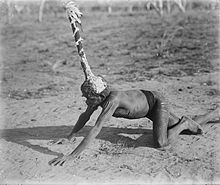 Kolaia man wearing a headdress worn in a fire ceremony, Forrest River, Western Australia. Aboriginal Australian religious practices associated with the Dreamtime have been practised for tens of thousands of years.
Kolaia man wearing a headdress worn in a fire ceremony, Forrest River, Western Australia. Aboriginal Australian religious practices associated with the Dreamtime have been practised for tens of thousands of years.
Australia has no official state religion and Section 116 of the Australian Constitution prohibits the Commonwealth government from establishing a church or interfering with the freedom of religion.[86] According to the 2006 Australian Census, 63.9% of Australians were listed as Christian. Historically, this proportion has been higher and a growing proportion of the population define themselves as irreligious, with 18.7% of Australians declaring 'no-religion' on the census. There are also growing communities of various other religions in Australia and 11.2% of people did not answer the question on the census.[87]
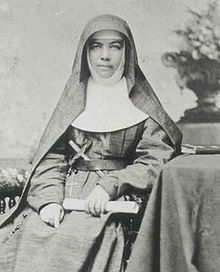 St Mary Mackillop established an extensive network of schools and is Australia's first canonised saint of the Catholic Church.
St Mary Mackillop established an extensive network of schools and is Australia's first canonised saint of the Catholic Church.
 Nan Tien Temple, Wollongong. Multicultural immigration is increasing the diversity of religion in Australia.
Nan Tien Temple, Wollongong. Multicultural immigration is increasing the diversity of religion in Australia.
Of the roughly 64% identifying as Christian, the largest proportions were either Roman Catholic (25.8%) or Anglican (18.7%), with the third largest group being the 5.7% affiliated with the Uniting Church. Most other major religious faiths are also practised in Australia, reflecting the cultural diversity of the nation.[87]
At the time of Federation in 1901, 97% of Australians professed to be Christians and Christianity has had an enduring impact on Australia. The Anglican Church (formerly known as the Church of England) remained the largest denomination until 1986, when it was surpassed by the Roman Catholic Church. Australian Catholics were predominantly of Irish origin until the post-world war two immigration program brought more than a million Catholics from Italy, Malta, the Netherlands, Germany, Croatia, Hungary and elswhere. The Christian festivals of Christmas and Easter are national public holidays in Australia and Christian charitable organisations, hospitals and schools have played a prominent role in welfare and education since colonial times. In 2008, 697 000 Australian children (20% of total students) attended Catholic schools,[88] and 750 000 attended church affiliated schools more generally (some of these being independent Catholic schools). Christian organisations such as the St. Vincent de Paul Society, the Salvation Army and Anglicare povide high profile social services throughout Australia. Christians have played a prominent role in Australian history and two Christian preachers feature on the Australian currency: David Unaipon, an Aboriginal writer and the Reverend John Flynn who founded the Royal Flying Doctor Service. Mary MacKillop, who co-founded an order of nuns in the 19th century, called the Sisters of St. Joseph, became the first Australian canonised saint of the Catholic Church in October 2010 and Sir Douglas Nicholls, a preacher and Aboriginal rights activist was the first indigenous Australian to be appointed Governor of an Australian State. Some Australian Prime Ministers in recent times have identified as religious, others as non-religious, and the separation of church and state is enshrined in Australian law and acknowledged as important in greater society.
The proportion of the total population who are Christian fell from 71% in 1996 to around 64% in 2006, while people affiliated with non-Christian religions increased from around 3.5% to 5.6% over the same period. Buddhism increased most rapidly from 1.1% to 2.1%. Increased immigration from South-East Asia has been a major factor in this growth, but Australians of Anglo-Celtic origin have also shown increasing interest in Buddhism. Islam increased during the period from 1.1% to 1.7% with diverse communities concentrated mainly in Sydney and Melbourne. The history of the Jews in Australia dates back to 1788 and the Jewish convicts brought to Sydney aboard the First Fleet. Today, an estimated 120,000 Jews reside in Australia, many of them originating as refugees and Holocaust survivors who arrived during and after World War II.[89] Hindus came to Australia as labourers and merchants during the 19th century and numbers increased dramatically from the 1960s, more than doubling between 1996 and 2006 to reach 148 000 people.[87]
The tradition and spirituality of Aboriginal Australians places great emphasis, as with every religious tradition, on the role of tribal Elders in passing down stories of the Dreaming, and skills and lessons for survival (such as hunting and tracking). The creation story and belief system of the Aboriginal tradition, known in English as the Dreamtime, reverences the land and the animals and spirits that inhabit that land. European settlement introduced Indigenous Australians to Christianity, especially through 'missions'. There was a wide range of experiences of the 'missions' by Aboriginal people.[87]
Public holidays
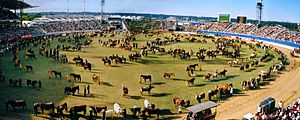 The Grand Parade of the Sydney Royal Easter Show. Easter is an extended public holiday in Australia accompanied by many public events.
The Grand Parade of the Sydney Royal Easter Show. Easter is an extended public holiday in Australia accompanied by many public events.
Australia's calendar of public holiday festivals begins with New Year's Day, the first of January. This is also the day upon which the Australian Federation officially came in to being, however the national day, Australia Day, is celebrated on 26 January, which was the date of the official foundation of the first British colony at Sydney in 1788, an important beginning in modern Australian immigrant history. Anzac Day, 25 April is another day strongly associated with Australian nationhood, however it more particularly commemorates Australians who fought in wars and is named to honour the soldiers of the Australian and New Zealand Army Corps who landed at Gallipoli, on that same day in 1915, during the First World War.
The Christian festivals of Easter and Christmas are public holidays in Australia. Christmas Day, 25 December, falls during the Southern Hemisphere summer.
Labour Day is also a public holiday, but on different days throughout the nation. The Queen's Birthday is generally observed on the second Monday in June, except in Western Australia, where it usually observed in September or October to move it away from Foundation Day. On the Queen's Birthday holiday, as on Australia Day, national awards are distributed to distinguished citizens for services to the community.
Cuisine
 Sheep grazing in rural Australia. Early British settlers introduced Western stock and crops and Australian agriculture now produces an abundance of fresh produce.
Sheep grazing in rural Australia. Early British settlers introduced Western stock and crops and Australian agriculture now produces an abundance of fresh produce.
 Chinatown, Sydney. Multicultural immigration to Australia has contributed to the development of a diverse cuisine.
Chinatown, Sydney. Multicultural immigration to Australia has contributed to the development of a diverse cuisine.
Contemporary Australian cuisine combines British and indigenous origins with Mediterranean and Asian influences. Australia's abundant natural resources allow access to a large variety of quality meats, and to barbecue beef or lamb in the open air is considered a cherished national tradition. The great majority of Australians live close to the sea and Australian seafood restaurants have been listed among the world's best.[90]
Bush tucker is an Australian term used to describe the traditional diets of indigenous Australians. Much of this food may be considered as having been uniquely Australian - from such food items as macadamia nuts to kangaroo meat (which is undergoing a renaissance of interest on contemporary Australian menus). A popular modern exponent of bush tucker has been television personality Les Hiddins, known as The Bush Tucker Man.
Early British settlers brought familiar meats and crops with them from Europe and these remain important in the Australian diet. The British settlers found some familiar game - such as swan, goose, pigeon and fish - but the new settlers often had difficulty adjusting to the prospect of native fauna as a staple diet.[91] They established agricultural industries producing more familiar Western style produce. Queensland and New South Wales became Australia's main beef cattle producers, while dairy cattle farming is found in the southern states, predominantly in Victoria. Wheat and other grain crops are spread fairly evenly throughout the mainland states. Sugar cane is also a major crop in Queensland and New South Wales. Fruit and vegetables are grown throughout Australia.[92] "Meat and three veg", fish and chips and the Australian meat pie continue to represent traditional meals for many Australians. The post-World War II multicultural immigration program brought new flavours and influences, with waves of immigrants from Greece, Italy, Vietnam, China and elsewhere bringing about diversification of the typical diet consumed.
Australia's 11 million square kilometre fishing zone is the third largest in the world and allows for easy access to seafood which significantly influences Australian cuisine. Clean ocean environments produce high quality seafoods. Lobsters, prawn, tuna, salmon and abalone are the main ocean species harvested commercially, while aquaculture produces more than 60 species for consumption, including oysters, salmonoids, southern bluefin tuna, mussels, prawns, barramundi, yellowtail kingfish, and freshwater finifish.[93] While inland river and lake systems are relatively sparse, they nevertheless provide some unique fresh water game fish and crustacea suitable for dining. Fishing and aquaculture constitute Australia's fifth most valuable agricultural industry after wool, beef, wheat and dairy.[94] Approximately 600 varieties of marine and freshwater seafood species are caught and sold for both local and overseas consumption. Popular seafoods of local origin include barramundi, flathead, and the balmain bug, while the popularity of Australian prawns led to a successful tourism campaign in the 1980s in which actor/comedian Paul Hogan invited Americans to come to Australia where he would "throw a shrimp on the barbie for ya".[95]
Vegemite is a well-known spread originating from Australia, though currently produced by the US-owned food company Kraft Foods.[96] Iconic Australian desserts include pavlova and lamingtons.[97] ANZAC biscuits recall the diet of Australia's World War I soldiers at the Battle of Gallipoli.
Beverages
Australia's reputation as a nation of heavy drinkers goes back to the earliest days of colonial Sydney, when rum was used as currency and grain shortages followed the installation of the first stills.
Billy tea is the drink prepared by the ill-fated swagman in the popular Australian folksong Waltzing Matilda. Boiling water for tea over a camp fire and adding a gum leaf for flavouring remains an iconic traditional Australian method for preparing tea, which was a staple drink of the Australian colonial period.[98]
The Australian Wine Industry is the fourth largest exporter of wine around the world and contributes $5.5 billion per annum to the nation's economy. In the early 21st century, Australians consume nearly 500 million litres of wine per year. Wine is produced in every state, however wine regions are mainly in the southern, cooler regions. Amongst the most famous wine districts are the Hunter Valley and Barossa Valley and among the best known wine producers are Penfolds, Rosemount Estate, Wynns Coonawarra Estate and Lindemans.[99]
Beer in Australia has been popular since colonial times. James Squires is considered to have founded Australia's first commercial brewery in 1798 and the Cascade Brewery in Hobart, Tasmania has been operating since the early 19th century. Since the 1970s, Australian beers have become increasingly popular globally - with Foster's Lager being an iconic export brand. Fosters is not however the biggest seller on the local market, with alternatives including Victoria Bitter outselling the popular export.
Clothing and apparel
Australia has no official designated national dress, but iconic local styles include bushwear and surfwear.[100] Australian designers and models also feature at international creative glamour fashion industry gatherings. The country's best-known fashion event is Australian Fashion Week, a twice yearly industry gathering showcasing the latest seasonal collections from Australian and Asia Pacific Designers.[101] Top Australian models include Elle McPherson, Lara Bingle and Jennifer Hawkins (Miss Universe 2004).
Major examples of clothing brands associated with bushwear are the broad brimmed Akubra hats and R.M. Williams bushmen's outfitters (featuring in particular: moleskin trousers, riding boots and merino woolwear). Blundstone Footwear and Country Road are also linked to this tradition. The cork hat is a type of headgear strongly associated with Australia, and comprises cork strung from the brim, to ward off insects. It is traditionally worn by jackaroos and swagmen in the blow-fly infested Australian outback.[102] Movement of the head causes the corks to swing, discouraging insects from swarming around the wearer's head. At the 2007 APEC Summit in Sydney and the 2009 Pacific Islands Forum in Cairns, the gathered world leaders were clothed in Australian bushwear: Driza-Bone jackets and R.M. Williams respectively.[103][104] Driza-Bone coats were also worn by the stockmen and the music band at the 2000 Summer Olympics opening ceremony in Sydney. Medal presenters during the 2000 Summer Olympic Games also wore Driza-Bone coats.[105]
Famous surfwear labels include Billabong, Rip Curl, Mambo and Quiksilver, which are sold and recognised around the world.
Ugg boots are unisex sheepskin boots, made of twin-faced sheepskin with fleece on the inside and with a tanned outer surface, often with a synthetic sole which were first developed in Australia or New Zealand. Traditionally worn for comfort and favoured by the working classes in Australia, since 2000 the boot style has experienced a world-wide growth in popularity as fashion.[106]
The slouch hat was first worn by military forces in Australia in 1885, looped up on one side so that rifles could be held at the slope without damaging the brim. After federation, the slouch hat became standard Australian Army headgear in 1903 and since then it has developed into an important national symbol and is worn on ceremonial occasions by the Australian army.[107]
Sport
Many Australians are passionate about sport, and it forms a major part of the country's culture, particularly in terms of spectating, but also in terms of participation. Cricket is popular in the summer and football codes are popular in the winter, with different codes being more popular in different areas. Some strong Australian traditions, such as grand finals and footy tipping are shared across all codes.
The sporting successes of Australians at elite levels in such events as the Olympic and Commonwealth Games, World Cup competitions in cricket, rugby union, rugby league, field hockey, netball, and major tournaments in tennis, golf, surfing and other sports are a source of great pride for many people in Australia. Leading sportspeople such as Don Bradman, Dawn Fraser and Cathy Freeman last in the cultural memory of Australia for decades and are accorded high civilian honours and public status.[108]
Australian rules football
Australian rules football (usually called "Aussie rules", "AFL" or "footy") is a popular spectator sport and a participation sport in all Australian states and territories, though its core support lies in four of the six states; Victoria, South Australia, Western Australia and Tasmania. The national competition, the Australian Football League, evolved from a Victorian state competition and is in the process of expanding from 16 to 18 teams from all states except Tasmania. The AFL Grand Final is traditionally played each year at the Melbourne Cricket Ground. Australian rules football culture has a strong set of rituals and traditions, many of which have crossed sporting boundaries in Australia. Traditional variations such as kick-to-kick are important aspects of the sporting culture, as is vocal support for a team, known as barracking.
Cricket
Cricket has been among the most popular sports in Australia since colonial times. The game is played during the summer months at a local, state and international level, with international matches drawing large crowds. It is featured and followed in all states and territories, unlike the football codes whose popularity varies dramatically between regions. A census conducted on behalf of Cricket Australia found that in the 2003-04 season there were 471,329 male participants in Australian cricket programs and competitions, and 47,780 female participants.
The first recorded cricket match in Australia took place in Sydney in 1803. Intercolonial cricket in Australia started in 1851[109] and Sheffield Shield inter-state cricket continues to this day. The 1876-77 season was notable for a match between a combined XI from New South Wales and Victoria and the touring Englishmen at the Melbourne Cricket Ground, which was later recognised as the first Test Match.[110] A famous victory on the 1882 tour of England resulted in the placement of a satirical obituary in an English newspaper saying that English cricket had "died", and the body will be cremated and the ashes taken to Australia. The English media then dubbed the next English tour to Australia (1882–83) as the quest to "regain the ashes".[111] The tradition continues with The Ashes series remaining one of the most anticipated events on the Australian sporting calendar.
Successful cricket players become major and often long lasting celebrities in Australia. Sir Donald Bradman, who made his Test debut in the 1928-29 series against England, remains a household name as the greatest batsman the game has ever known and a byword for sporting excellence.[112] Bradman retired in 1948 but was later knighted for services to cricket and given a state funeral upon his death in 2001.[112] Other figures from the game – such as Richie Benaud, Dennis Lillee and Shane Warne – remain household names despite having retired years or decades ago. Internationally, Australia has for most of the last century sat at or near the top of the cricketing world. The Australian media tycoon Kerry Packer altered the traditionalist ethos of the game in the 1970s, inventing World Series Cricket from which have evolved many aspects of the various modern international forms of the game.
Events on the cricket pitch have occasionally even been elevated to diplomatic incidents in Australian history – as occurred in the infamous Bodyline controversy of the 1930s, in which an English team bowled in a physically intimidating way leading to accusations of unsportsmanlike conduct.[113] The Australian team was banned from touring South Africa in the 1970s in protest against the racist policies of its government and more recently, Prime Minister John Howard intervened to ban the national side from touring Robert Mugabe's Zimbabwe.[114][115]
Rugby league
 The first State of Origin shield, depicting Queensland's Wally Lewis and New South Wales' Brett Kenny.
The first State of Origin shield, depicting Queensland's Wally Lewis and New South Wales' Brett Kenny.
In 1908, rugby league was established in Australia by former rugby union players and supporters as a breakaway professional code. The new code gained and has maintained a wider following in Australia than rugby union, which remained amateur until the 1990s.[116] It has traditionally been seen as a "working man's sport" with its roots in the working class communities of the northern English counties of Lancashire and Yorkshire translating to similar areas of Western Sydney and Brisbane.
Rugby league is the most popular winter sport in New South Wales, Queensland and the Australian Capital Territory[citation needed]. The elite club competition is the National Rugby League (NRL), which features ten teams from New South Wales, three teams from Queensland, and one team each from Victoria, Australian Capital Territory and New Zealand. The season culminates in the premiership deciding game, the NRL Grand Final, traditionally one of Australia's most popular sporting events and one of the largest club championship matches in the world.[117] Rugby League is played in all Australian states and territories, but has a much reduced participation in the southern and western states, though there has been a team based in Victoria, the Melbourne Storm, since 1998.
The New South Wales Blues and Queensland Maroons play a representative series against each other every year, called the State of Origin series, which is one of Australia's major sporting events. In addition, the Australian Kangaroos represent the country in international matches. Since its inception in 1954, the Australian team has dominated the Rugby League World Cup, having won the competition nine times.[118]
Rugby union
 The Wallabies (Australian national rugby union team) compete for the ball in a lineout in a match against the South African Springboks.
The Wallabies (Australian national rugby union team) compete for the ball in a lineout in a match against the South African Springboks.
Reports of rugby union being played in Australia date back to the 1820s, with local clubs established by the 1860s.[116] The game has been especially popular as a winter sport in Queensland, New South Wales and the Australian Capital Territory. The Australian national rugby union team is called the Wallabies. In 1908, rugby league was established in Australia as a breakaway professional code which eventually gained a wider following than rugby union, which remained amateur until 1995. Since the 1920s the Wallabies have worn green and gold jerseys.[116] Despite having a relatively small player base, mainly in NSW and Queensland, the national side has twice won the Rugby World Cup – in 1991 and 1999. Australia hosted the 2003 Rugby World Cup, which saw the Wallabies defeated by England in the final at Telstra Stadium. Other notable competitions include the annual Bledisloe Cup played against Australia's traditional rivals, the New Zealand All Blacks since 1931, and the Tri-Nations competition involving South Africa and New Zealand.
The New South Wales Waratahs, Queensland Reds, ACT Brumbies, and WA's Western Force represent Australia in the Super Rugby provincial competition between southern hemisphere nations. The game's following is slowly growing out of traditional areas with new state teams established in Western Australia and Victoria to compete in the Super 14 competition – the Melbourne Rebels will join the competition in 2011.
Rugby test matches hold a significant place in the sports calendar of Australia, and have even at times become highly politicised; during the 1970s, in a significant move against South Africa's apartheid regime, many Australians (including Wallabies) demonstrated against tours by the racially selected South African team.[119] Australia has produced a number of notable rugby players of national stature, including Sir Edward Dunlop, Mark Ella (one of the first indigenous Australians to captain a national side) and the prolific try scorer David Campese.
Soccer
Soccer is Australia's highest participation football code in the country with both boys and girls at junior level as well with men and women at senior level. A number of major international stars have played for the national team in recent years including Tim Cahill, Mark Viduka, Mark Schwarzer and Harry Kewell.
Until recently, the most prominent soccer clubs were based around ethnic groups, mostly European. However, the national league was completely reformed in 2004, and the first season of the A-League began in September 2005. Several major names now play in the A-League, such as Robbie Fowler. The newly franchised teams have been able to translate good sponsorship at the national level into development of the game and junior participation has boomed.
Australia's national team, the Socceroos, as of 2010 has competed at three FIFA World Cups. The Australian Government sought to host the event, the world's most watched sporting event, in either 2018 or 2022 but the bid failed. In order to seek a higher level of competition, the Australian national team moved from the Oceania Football Confederation to the Asian Football Confederation in 2006, a much stronger confederation which has guaranteed places in the World Cup, thereby avoiding repetition of a history of missed opportunities in forced sudden-death playoffs.
Netball
Netball has the highest level of participation for a women's sport in Australia, and one of the largest numbers of participants for any Australian sport. The premier league is the ANZ Championship, formed in 2008, which includes five teams each from Australia and New Zealand. Formerly the premier league was the Commonwealth Bank Trophy, which began in 1997. The Australian National Netball Championships is an interstate youth competition. The governing body for the sport is Netball Australia, which was founded in 1927.[120]
The Netball World Championships is a quadrennial international netball world championship, inaugurated in 1963. Since its inception, the competition has been dominated primarily by the Australian national netball team (The Diamonds) and the New Zealand national netball team (the Silver Ferns).[121]
Water sports
Australia's warm climate and long coastline of sandy beaches and rolling waves provide ideal conditions for water sports such as swimming and surfing. The majority of Australians live in cities or towns on or near the coast, and so beaches are a place that millions of Australians visit regularly.[91]
Swimming is both a popular pastime for ordinary people and a sport in which Australian athletes have achieved success at a competitive level. The family of "Swimming Professor" Richmond Theophilus "Dick" Cavill (1884–1938) contributed significantly to the development of the sport of swimming; his son Arthur is credited by sports journalist W.F. Corbett with originating the Australian crawl stroke, which now predominates in "freestyle" swimming races. Another son, Sydney, was the originator of the butterfly stroke. Youngest son Richmond Theophilus was the first to use the crawl in a competition, winning 100 yards State championship in 1899 and in England, in 1902, he was the first to swim 100 yards in under a minute.[122] Australia has generally been a world power in Olympic swimming since the 1956 Melbourne Olympics; swimmers like Dawn Fraser, Kieren Perkins and Ian Thorpe have taken multiple gold medals.[123]
Beaches are public spaces in Australia, where people from all walks of life gather. Australians thus have a particular affinity for the sport of surf lifesaving. The world's first surf lifesaving club was founded at Bondi Beach, Sydney, in 1906 and surf life savers have a revered status in the national culture. Surf Life Saving Australia has conducted hundreds of thousands of rescues around Australia. From the junior Nippers to the adult Ironmen and Ironwomen, tens of thousands of Australians compete in surf lifesaving training and competitions, with Australian Surf Life Saving Championships attracting large interest.[91]
In the summer of 1915, Duke Kahanamoku of Hawaii introduced surf board riding to Sydney's Freshwater Beach, amazing locals and starting a long term love affair with the sport in Australia.[91] In 2007, both the male (Mick Fanning) and female (Stephanie Gilmore) ASP champions were Australian.
The Sydney to Hobart yacht race is a much anticipated fixture on the Australian sporting calendar. Australia won the America's Cup under skipper John Bertrand in 1983.
Other sports
 The Kiandra Snowshoe Carnival in 1900. Skiing in Australia began in this goldmining town in the Snowy Mountains of New South Wales in the 1860s.
The Kiandra Snowshoe Carnival in 1900. Skiing in Australia began in this goldmining town in the Snowy Mountains of New South Wales in the 1860s.
 Constitution Dock, in Hobart, Tasmania - the final destination of the annual Sydney-Hobart Yacht race
Constitution Dock, in Hobart, Tasmania - the final destination of the annual Sydney-Hobart Yacht race
Australians participate and excel in many other sports, including tennis, golf, basketball and motorsport.
Since the 1970s, gambling has become more easily accessible to the public, and consequently many Australians take an interest in sports on which they can bet, including mainstream sports such as cricket and football as well as traditional mediums for "punting" such as horse racing and greyhound racing.
Horse racing has had a prominent place in Australian culture since early days, with the first spectator sports event in Australia being NSW Governor Macquarie's race meeting at Hyde Park, Sydney in 1810.[124] The much loved Melbourne Cup is known as the "race that stops a nation" for the enthusiasm with which Australians natiowide tune in for the annual race. First run in 1861, by 1880 it was already known world-wide and was drawing crowds of 100,000.[125]
Australia has its own unique motor racing organisation, known as the V8 Supercars Touring Series. It has a considerable following in New Zealand, and is steadily growing in popularity across the world, where television coverage allows.
Several non-mainstream sports in Australia still attract a high standard from Australian teams due the sporting culture. For example, it regularly raises world-beating field hockey teams. Australian cyclists have recently been successful in the Tour de France and other international cycling competitions, most notably Cadel Evans' win in the 2011 Tour de France. In 2008, Australia's only major international cycling race, the Tour Down Under, centred around Adelaide, became the first UCI ProTour cycling race to be held outside of Europe. Among young people and within schools nationwide, various forms of handball or downball games have been among the most prevalent sports games for some decades.
Snow sports are enjoyed in the Australian Alps and in Tasmania. Skiing in Australia was first introduced by Norwegian miners in the goldrush town of Kiandra, New South Wales around 1859, near today's Selwyn Snowfields ski resort.[126] The sport remains a popular winter activity in the south-eastern states and territories. Major alpine skiing resorts include Thredbo, Perisher and Charlotte Pass in New South Wales; Mount Hotham, Falls Creek and Mount Buller in Victoria and Mount Ben Lomond in Tasmania. Extensive areas are available for cross country skiing within national parks including Kosciuszko National Park (NSW), Alpine National Park (VIC); Namadgi National Park (ACT) and in the Tasmanian Wilderness. Australia has long participated in the Winter Olympics and in recent decades, Australians have enjoyed medal successes at the Games - particularly in the sport of aerial skiing.
Australia's historical links to Britain have contributed to the establishment of strong traditions in sports of British origin, but in recent decades there has been a marked increase in interest and participation in American sports, particularly basketball. This has led to opportunities for Australians to play at the top level in sports such as baseball, basketball and American football. Grant Balfour is a relief pitcher for the Tampa Bay Rays, and played in the 2008 World Series. Australian basketballers have done well at the Olympics, coming fourth four times. Australians such as Luc Longley and Andrew Bogut have had long careers in the US National Basketball Association. Australian women have made an even bigger impact in the US Women's National Basketball Association, with Lauren Jackson captaining the Seattle Storm, and the Australian women's basketball team have won three silver and one bronze medal at the Olympics. The skill set of Australian Rules footballers fits the mould of US National Football League (NFL) punters, and they stand out from their American peers with their ability to tackle returners. Two former AFL footballers competed in the 2009 NFC Championship game as punters, Saverio Rocca for the Philadelphia Eagles and Ben Graham for the Arizona Cardinals. Graham's appearance in Super Bowl XLIII made him the first Australian to play in the NFL's championship game.
Attitudes, beliefs and stereotypes
Australians have very strong attitudes and beliefs which are reinforced by the tenets of the country's society.
The Australian national character has been forged by the difficulty of subduing the land. Unlike other cultures based on a nurturing landscape that they seek to protect from others, Australian settlers experienced great hardship and had to support each other in order to survive. The battle against the elements led to the nickname of a member of Australia's working class being the 'Aussie battler'.
The need to laugh in the face of danger while battling the landscape has provoked a strange view of the world, with a distinctive upside-down sense of humour. Times of hardship or even disaster are ridiculed, and this extends to the Australian delight in dubbing a tall man "Shorty," a quiet one "Rowdy," a bald man "Curly" and a redhead "Bluey".
Mateship
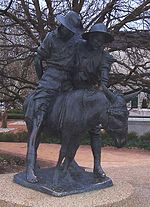 A commemorative statue of John Simpson Kirkpatrick, a famous stretcher bearer who was killed in the Gallipoli Campaign.
A commemorative statue of John Simpson Kirkpatrick, a famous stretcher bearer who was killed in the Gallipoli Campaign.
"Mateship", or loyal fraternity, has been a central tenet of survival in the harsh landscape. Mateship can be defined as the code of conduct, particularly between men, although more recently also between men and women, stressing equality and friendship. Mateship is seen as an important element of the qualities that the Australian Defence Force values in its troops. The glorification of Australia's early soldiers in the Boer War and World War I reinforces these values. This may also explain why sport plays such a central role in Australian culture.
An aspect of the mateship culture on language is that Australians have a propensity for the diminutive forms of names (e.g. Hargrave -> Hargie; Wilkinson -> Wilko; John -> Johnno; David-> Davo; Hogan -> Hoges; James -> Jimmy -> Jim -> Jimbo). This is a display of affection and acceptance rather than belittlement.
One result of the prevalence of the 'mateship' culture is that Australian society is stringently anti-hierarchical. Australians are expected to behave with humility and not think of themselves as better than their peers. Any disloyalty to their 'mates' is treated harshly, and is known as the tall poppy syndrome, where people who grow greater than their peers are harshly criticised as being narcissistic, or 'up themselves'. Even the most successful and beautiful Australians are eager to proclaim how ordinary they are. This egalitarian social system makes Australian society appear 'laid-back', or relaxed to visitors. Most forms of address are by first name or nickname, and only children regularly use titles such as 'Mister' or 'Sir' for authority figures.
The mateship culture combined with the original convict and then colonial culture has created an irreverence for established authority, particularly if it is pompous or out of touch with reality. Politicians, or "pollies", are generally disliked and distrusted. Politicians who seek to lead must comply to the views of the egalitarian electorate, who will punish any hint of arrogance or glory-seeking behaviour. Voter turnout at elections had in fact been so low that compulsory voting was introduced for the 1925 federal election.[127]
The phrase, "the lucky country", coined by Donald Horne, is a sobriquet used to describe Australia in terms of weather, lifestyle and history.[128] Ironically, Horne was using the term to criticise the complacency of Australian society in the early 1960s.[6]
Folklore
Australian stories and legends have a cultural significance independent of their empirical truth or falsehood. This can be seen in the national obsession with the almost mythological portrayal of bushranger Ned Kelly as a mixture of the underdog and Robin Hood.
Australian history glorifies its sportsmen and its soldiers. Yet like many legends, truths do stem from it. Australia has shown, in the past and present, that for a country of just over 23 million people, it is capable of extraordinary things in the sporting arenas, such as the 49 medals won at the 2004 Athens Olympic Games. Militarily, Australians have served in numerous overseas wars, ranging from the Battle of Gallipoli, through to recent regional security missions, such as East Timor, Iraq and Afghanistan.
Australian war culture is somewhat different from most other western cultures. It generally consists of sombre reflection and commemoration of all who have died in wartime and honouring those who lived. It focuses on noble sacrifice rather than glory. An annual national holiday, Anzac Day exists for this purpose.
The Australian experience of defeat in the Gallipoli Campaign of World War I, which is viewed as the first iconic moment in modern Australian war involvement, is viewed by Australians with both pride for the fighting of the soldiers, and bitterness for the perceived negligence on the part of British commanders. The incidences of valour, bravery, and determination displayed during the campaign for Gallipoli, as well as the mutual respect for their Turkish adversaries led by Kemal Atatürk, is seen as part of the ANZAC spirit. This experience of war was repeated at battles on the Western Front, such as the Battle of Passchendaele.
During the latter part of the First World War the legend of Australians being great soldiers was entrenched as the Australian Imperial Force was used as the shock troops of the British Empire forces. The Battle of Amiens, known as the "Black Day of the German Army", was a campaign in which Australian soldiers played a crucial role. The Australians were considered to be remarkably determined, united and hard-working soldiers. Many Australians knew how to ride and shoot prior to enlistment, making them talented recruits, but the Australian soldiers were infamous for their lax attitude towards formal parade ground discipline, a notoriety that the Australian soldiers revelled in. From this the notion of the larrikin Digger emerged, an important part of contemporary Australian identity.
Customs
Friendly rivalry
Australians and New Zealanders have a rivalry, especially in certain sports such as rugby league, rugby union and netball. The rivalry is often compared to brothers in the same family competing against each other.[citation needed]
The biggest sporting rivalry exists between Australia and England. As Australians see New Zealanders as their little brother they see the English as big brother, with more people, history and money. The sporting arena was a place where Australians could shine.
The Australian dream
The Australian dream of home ownership underpins suburban Australia. However, this has been challenged by the low affordability of housing in Australia.
"Underdog" identity
As well as the prevalence of the tall poppy syndrome bringing back to Earth the high fliers, the egalitarian Australian society has a traditional Australian support for the "underdog". Australians will show support for those who appear to be at a disadvantage even when the underdog is competing against fellow Australians.
This underdog attitude is most evident in sport, as sport is also a large part of Australian culture. Should an Australian be asked to choose between two unknown competitors, very often they will choose the one least likely to win, such as swimmer Eric the Eel during the 2000 Olympics. The success of Steven Bradbury in the 2002 Winter Olympics who won a skating gold medal after all his competitors crashed has coined the expression 'doing a Bradbury' which underpins the spirit of the underdog, positive thinking and never giving up.
During the 2003 Rugby World Cup, the Georgian rugby team arrived in Perth with a crowd of Perth residents welcoming them with colourful support, and a similar occurrence was noted in Townsville, Queensland where the Japanese rugby team was preferred to that of the French.[129]
A "fair go"
The belief in a "fair go" is a key part of Australian culture and Australian society, related to the support for the underdog.[130] This can be seen in the existence of strong public health and education systems in Australia, and equal opportunity legislation to ensure people are not excluded from jobs or positions by their race, gender or sexual preference.
Cultural cringe
The idea of cultural cringe was defined by Australian sociologists Brian Head and James Walter as the belief that one's own country occupies a "subordinate cultural place on the periphery", and that "intellectual standards are set and innovations occur elsewhere". As a consequence, a person who holds this belief is inclined to devalue their own country's cultural, academic and artistic life, and to venerate the "superior" culture of another country.
Further reading
- Bambrick, Susan ed. The Cambridge Encyclopedia of Australia (1994)
- Bennett, Bruce et al. The Oxford Literary History of Australia (1999)
- Bennett, Tony, and David Carter. Culture in Australia: Policies, Publics and Programs (2001) excerpt and text search
- Carey, Hilary. Believing in Australia: A Cultural History of Religions (1996)
- Crawford, Robert. But Wait, There's More... a History of Australian Advertising 1900-2000
- Hernández, Ramona. Muslims in Australia: Immigration, Race Relations and Cultural History (2004)
- Horton, David. The Encyclopedia of Aboriginal Australia: Aboriginal and Torres Strait Islander History, Society and Culture (2001)
- Huggan Graham. Postcolonialism, Racism, Transnationalism (Oxford Studies in Postcolonial Literatures) (2007) excerpt and text search
- Johnson, Bruce. "White Noise: Jazz and Australian Modernisation," ACH: The Journal of the History of Culture in Australia, 2006, Vol. 25, pp 251–272,
- Kleinert, Sylvia. and Margo Neale. The Oxford Companion to Aboriginal Art and Culture (2001)
- Leitner, Gerhard. Australia's Many Voices: Australian English—the National Language (2004) excerpt and text search
- McAllister, Ian, Steve Dowrick, Riaz Hassan; The Cambridge Handbook of the Social Sciences in Australia Cambridge University Press, 2003 online edition
- McCulloch, Alan. Encyclopedia of Australian Art 2 vol (1984)
- McDonald, John. Federation: Australian Art and Society, 1901-2001. Natl. Gallery of Australia, 2002. 264 pp.
- Nile, Richard. The Making of the Australian Literary Imagination. (2002). 315 pp.
- O'Shane, Pat et al. Australia: The Complete Encyclopedia (2001)
- Rickard, John, Australia: A Cultural History (1988)
- Serle. Percival, ed. Dictionary of Australian Biography (1949)online edition
- Webby, Elizabeth. The Cambridge Companion to Australian Literature (2000) excerpt and text search
- Wilde, William H. et al. eds. The Oxford Companion to Australian Literature (1995) online at OUP excerpt and text search
- Samuels, Selina, ed. Australian Writers, 1915-50. (2002). 510 pp.
- Sayers, Andrew. Australian Art (2001) excerpt and text search
- Webby, Elizabeth, ed. The Cambridge Companion to Australian Literature (2006)
- Wannan, Bill. A Dictionary of Australian Folklore: Lore, Legends, Myths and Traditions (1988)
References
- ^ "About Australia: Indigenous peoples: an overview". Department of Foreign Affairs and Trade. http://www.dfat.gov.au/facts/Indigenous_peoples.html. Retrieved 2010-09-26.
- ^ a b Geoffrey Blainey; A Very Short History of the World; Penguin Books; 2004; ISBN 978-0-14-300559-9
- ^ a b c "About Australia: People, culture and lifestyle". Dfat.gov.au. http://www.dfat.gov.au/facts/people_culture.html. Retrieved 2011-01-29.
- ^ "Documenting a Democracy - South Australia Act, or Foundation Act, of 1834 (UK)". Museum of Australian Democracy. http://foundingdocs.gov.au/item.asp?sdID=37. Retrieved 2011-06-11.
- ^ AEC.gov.au
- ^ a b AEC.gov.au
- ^ "AEC.gov.au". AEC.gov.au. 25 Oct. 2007. http://www.aec.gov.au/Voting/indigenous_vote/indigenous.htm. Retrieved 27 Jun. 2010.
- ^ Foundingdocs.gov.au
- ^ Brodie, Scott (1999). Our Constitution. Franklin Watts Australia. pp. 4–8. ISBN 978-0-9585649-0-8.
- ^ Human Rights under the Australian Constitution by George Williams - [1999] MULR 31; (1999) 23 Melbourne University Law Review 817
- ^ Australian Immigration Fact Sheet 8. Abolition of the 'White Australia' Policy
- ^ "Migration" (PDF). 2006 Census. Australian Bureau of Statistics. 29 March 2007. http://www.ausstats.abs.gov.au/ausstats/subscriber.nsf/0/E0A79B147EA8E0B5CA2572AC001813E8/$File/34120_2005-06.pdf. Retrieved 2009-03-06. (table 6.6)
- ^ Geoffrey Bolton (1990) p.193 and 195
- ^ Electoral Milestone / Timetable for Indigenous Australians - Australian Electoral Commission
- ^ "Colliding worlds: first contact in the western desert, 1932–1984". Recollections.nma.gov.au. http://recollections.nma.gov.au/issues/vol_1_no_2/exhibition_reviews/colliding_worlds/. Retrieved 12 Oct. 2009.
- ^ Australian Immigration Fact Sheet 60 - Australia's Refugee and Humanitarian Program Archived 6 September 2008 at WebCite
- ^ Australia in Brief: Australia - an overview - Department of Foreign Affairs and Trade
- ^ It's an Honour - Symbols - Other Australian Flags
- ^ Department of Foreign Affairs and Trade
- ^ Dalby, Andrew (1998). Dictionary of Languages. Bloomsbury Publishing plc. p. 43. ISBN 978-0-7475-3117-3.
- ^ a b Australian humour - australia.gov.au
- ^ Henry Lawson: Australian writer - australia.gov.au
- ^ Australians in France: 1918 - Friends and Foe - Australian soldiers' relations with their superiors | Australian War Memorial
- ^ Barry Humphries - australia.gov.au
- ^ Barry Humphries | Absurd moments: in the frocks of Dame Edna
- ^ Media Releases | Oxfam Australia
- ^ a b "Young crowd goes 'yum, yum' over veteran Goodies - Arts - Entertainment". Smh.com.au. 17 October 2009. http://www.smh.com.au/news/entertainment/arts/young-crowd-goes-yum-yum-over-veteran-goodies/2009/10/17/1255624772594.html. Retrieved 2011-01-29.
- ^ a b "Australian painters". Australian Culture and Recreation Portal. Australia Government. http://www.cultureandrecreation.gov.au/articles/painters/. Retrieved 16 February 2010.
- ^ "Film in Australia - Australia's Culture Portal". Cultureandrecreation.gov.au. http://www.cultureandrecreation.gov.au/articles/film/. Retrieved 2011-01-29.
- ^ "Australia in Brief: Culture and the arts - Department of Foreign Affairs and Trade". Dfat.gov.au. 1 July 2008. http://www.dfat.gov.au/aib/arts_culture.html. Retrieved 2011-01-29.
- ^ "Opera in Australia - Australia's Culture Portal". Cultureandrecreation.gov.au. 23 February 1931. http://www.cultureandrecreation.gov.au/articles/music/opera/. Retrieved 2011-01-29.
- ^ "Australian language, letters and literature - Australia's Culture Portal". Cultureandrecreation.gov.au. http://www.cultureandrecreation.gov.au/articles/literature/. Retrieved 2011-01-29.
- ^ "Henry Lawson: Australian writer - Australia's Culture Portal". Cultureandrecreation.gov.au. 2 September 1922. http://www.cultureandrecreation.gov.au/articles/lawson/. Retrieved 2011-01-29.
- ^ a b Seal, Graham (1989). The Hidden Culture: Folklore in Australian Society. Melbourne: Oxford University Press. p. 50. ISBN 978-0-19-554919-5.
- ^ "Oodgeroo Noonuccal." Encyclopedia of World Biography Supplement, Vol. 27. Gale, 2007
- ^ "Australian Indigenous ceremony - Australia's Culture Portal". Cultureandrecreation.gov.au. 15 January 2008. http://www.cultureandrecreation.gov.au/articles/indigenous/ceremony/. Retrieved 2011-01-29.
- ^ a b "Our Country's Good: The Recruiting Officer". Olioweb.me.uk. http://www.olioweb.me.uk/plays/. Retrieved 2011-01-29.
- ^ "a great night out! - Hobart Tasmania". Theatre Royal. http://www.theatreroyal.com.au/history.html. Retrieved 2011-01-29.
- ^ [1][dead link]
- ^ "Melbourne Athenaeum Library - History of the Melbourne Athenaeum". Melbourneathenaeum.org.au. http://www.melbourneathenaeum.org.au/content/view/20/37/. Retrieved 2011-01-29.
- ^ "Queen's Theatre". History.sa.gov.au. 1 July 2010. http://www.history.sa.gov.au/queens/about.htm. Retrieved 2011-01-29.
- ^ [2][dead link]
- ^ "Entertainment | The man behind Dame Edna Everage". BBC News. 15 June 2007. http://news.bbc.co.uk/2/hi/entertainment/6757531.stm. Retrieved 2011-01-29.
- ^ "About Us - National Institute of Dramatic Art". NIDA. http://www.nida.edu.au/default.aspx?FolderID=15. Retrieved 2011-01-29.
- ^ "History". Adelaide Festival Centre. 2 June 1973. http://www.adelaidefestivalcentre.com.au/afc/history.php. Retrieved 2011-01-29.
- ^ "Robert Helpmann". Helpmannawards.com.au. 28 September 1986. http://www.helpmannawards.com.au/default.aspx?s=sir_robert_helpmann. Retrieved 2011-01-29.
- ^ "About". Sydneytheatre.com.au. http://www.sydneytheatre.com.au/about. Retrieved 2011-01-29.
- ^ Review: Ngapartji Ngapartji, Belvoir Street Theatre | thetelegraph.com.au
- ^ "reCollections - Australia's Muslim cameleer heritage". Recollections.nma.gov.au. http://recollections.nma.gov.au/issues/vol_2_no2/notes_and_comments/australias_muslim_cameleer_heritage/. Retrieved 2011-01-29.
- ^ "Nan Tien Temple-History of Temple". Nantien.org.au. 28 November 1991. http://www.nantien.org.au/en/about/history.asp. Retrieved 2011-01-29.
- ^ "The Great Synagogue Sydney > Home". Greatsynagogue.org.au. http://www.greatsynagogue.org.au/. Retrieved 2011-01-29.
- ^ "Kakadu National Park - Home". Environment.gov.au. 7 January 2011. http://www.environment.gov.au/parks/kakadu/. Retrieved 2011-01-29.
- ^ "Uluru-Kata Tjuta National Park". Environment.gov.au. Archived from the original on 2010-01-17. http://www.environment.gov.au/parks/uluru/index.html. Retrieved 2011-01-29.
- ^ "Ku Ring Gai Chase National Park, Sydney, Australia. Information and Map". Auinfo.com. http://www.auinfo.com/Ku_Ring_Gai_National_park_Sydney.html. Retrieved 2011-01-29.
- ^ "Indigenous art". Australian Culture and Recreation Portal. Australia Government. http://www.cultureandrecreation.gov.au/articles/indigenous/art/index.htm. Retrieved 2010-09-26.
- ^ "Chronology of events | Archibald Prize 2010". Thearchibaldprize.com.au. http://thearchibaldprize.com.au/history/chronology/. Retrieved 2011-01-29.
- ^ Button, James (2005-12-20). "Rolf Harris makes the Queen look a picture - World". Melbourne: theage.com.au. http://www.theage.com.au/news/world/rolf-makes-the-queen-look-a-picture/2005/12/19/1134840800380.html. Retrieved 2011-01-29.
- ^ Robert Hughes; The Art of Australia; Penguin; Revised Edition 1970
- ^ "The Michael Leunig Website". Leunig.com.au. http://www.leunig.com.au/. Retrieved 2011-01-29.
- ^ "Australia's first film studio". Salvationarmy.org.au. 15 January 2010. http://www.salvationarmy.org.au/SALV/STANDARD/PC_60860.html. Retrieved 2011-01-29.
- ^ "The Story of the Kelly Gang (1906) on ASO - Australia's audio and visual heritage online". Aso.gov.au. http://aso.gov.au/titles/features/story-kelly-gang. Retrieved 2011-01-29.
- ^ "In the Wake of the Bounty (1933) on ASO - Australia's audio and visual heritage online". Aso.gov.au. http://aso.gov.au/titles/features/wake-bounty/. Retrieved 2011-01-29.
- ^ "Festival de Cannes - From 11 to 22 may 2011". Festival-cannes.com. http://www.festival-cannes.com/en/archives/ficheFilm/id/3702/year/1955.html. Retrieved 2011-01-29.
- ^ "Kokoda Front Line! (1942) on ASO - Australia's audio and visual heritage online". Aso.gov.au. http://aso.gov.au/titles/newsreels/kokoda-front-line/. Retrieved 2011-01-29.
- ^ ""Fair Dinkum Fillums": the Crocodile Dundee Phenomenon". Cc.murdoch.edu.au. http://wwwmcc.murdoch.edu.au/ReadingRoom/film/Croc.html. Retrieved 2011-01-29.
- ^ http://www.australiamovie.net/2009/02/second-highest-grossing-australian-film-of-all-time/
- ^ Mitchell, Tony (1 April 2006). "The New Corroboree". The Age (Melbourne). http://www.theage.com.au/news/music/the-new-corroboree/2006/03/30/1143441270792.html.
- ^ "The Man must make his music". The Sydney Morning Herald. 26 March 2007. http://www.smh.com.au/news/music/the-man-must-make-his-music/2007/03/25/1174761263365.html.
- ^ "Waltzing Maltida a little ditty, historians say - ABC News (Australian Broadcasting Corporation)". Abc.net.au. 5 May 2008. http://www.abc.net.au/news/stories/2008/05/05/2235263.htm. Retrieved 2011-01-29.
- ^ "How to Do a Bush Dance". Home.hiwaay.net. http://home.hiwaay.net/~lkseitz/Australia/bushdance.html. Retrieved 2011-01-29.
- ^ info@thebushwackers.com.au. "The Bushwackers". The Bushwackers. http://www.thebushwackers.com.au/. Retrieved 2011-01-29.
- ^ a b c d Oxford, A Dictionary of Australian Music, Edited by Warren Bebbington, Copyright 1998
- ^ "Melba, Dame Nellie (1861 - 1931) Biographical Entry - Australian Dictionary of Biography Online". Adb.online.anu.edu.au. http://www.adb.online.anu.edu.au/biogs/A100464b.htm. Retrieved 2011-01-29.
- ^ "John Antill : Represented Artist Profile". Australian Music Centre. http://www.australianmusiccentre.com.au/artist/antill-john. Retrieved 2011-01-29.
- ^ "Australian pop music - Australia's Culture Portal". Cultureandrecreation.gov.au. http://www.cultureandrecreation.gov.au/articles/music/pop/. Retrieved 2011-01-29.
- ^ "O'Keefe, John Michael (Johnny) (1935 - 1978) Biographical Entry - Australian Dictionary of Biography Online". Adb.online.anu.edu.au. http://www.adb.online.anu.edu.au/biogs/A150610b.htm. Retrieved 2011-01-29.
- ^ McFarlane, Ian (1999). "Encyclopedia entry for 'Renée Geyer'". Encyclopedia of Australian Rock and Pop. St Leonards, NSW: Allen & Unwin. ISBN 1864487682. http://web.archive.org/web/20040803174326/www.whammo.com.au/encyclopedia.asp?articleid=829. Retrieved 2009-05-07.[not in citation given]
- ^ "Civics | Paul Kelly (1955–)". Civicsandcitizenship.edu.au. Archived from the original on 2011-05-08. http://www.civicsandcitizenship.edu.au/cce/default.asp?id=15390. Retrieved 2011-01-29.
- ^ Dave" Laing, "Slim Dusty: Country singer famous for A Pub With No Beer", The Guardian (UK), 20 September 2003
- ^ (English) http://www.news.com.au/couriermail/extras/federation/Timelines/CMFedTimelineNat3.htm[dead link]
- ^ (English) http://www.news.com.au/entertainment/story/0,23663,20357015-5007183,00.html
- ^ (English) http://www.televisionau.com/seventies.htm
- ^ Logie Awards
- ^ Get the Picture - Free-to-air TV - Ratings - By network
- ^ http://www.aba.gov.au/contentreg/codes/television/documents/ACS2004Fulltext.pdf[dead link]
- ^ "Parliament of Australia: Senate: Constitution - Chapter 5". Aph.gov.au. 21 May 2003. http://www.aph.gov.au/senate/general/constitution/chapter5.htm. Retrieved 2011-01-29.
- ^ a b c d "About Australia: Religious Freedom". Dfat.gov.au. http://www.dfat.gov.au/facts/religion.html. Retrieved 2011-01-29.
- ^ WebCite query result
- ^ The Virtual Jewish History Tour: Australia
- ^ "The Top 50 Best Restaurants 1-50 | The World’s 50 Best Restaurants". Theworlds50best.com. 15 February 2010. http://www.theworlds50best.com/module/acms_winners?group_id=1. Retrieved 2011-01-29.[dead link]
- ^ a b c d "Surf Life Saving - Australia's Culture Portal". Culture.gov.au. 6 February 1938. http://culture.gov.au/articles/surflifesaving/. Retrieved 2011-01-29.
- ^ Australian farms and farming communities - australia.gov.au
- ^ About Australia: The Australian seafood industry
- ^ Fisheries Home - DAFF
- ^ "Come and Say G’Day!". Atme.org. http://www.atme.org/pubs/archives/77_1898_11926.cfm. Retrieved 2011-01-29.
- ^ Hildebrand, Joe (2009-10-02). "Old recipe jarred with new Mites". Daily Telegraph: p. 15. http://www.dailytelegraph.com.au/news/the-real-reason-for-the-isnack-20-the-original-vegemites-falling-sales-among-migrants/story-e6freuy9-1225781813838. Retrieved 2009-10-04.
- ^ Pavlova
- ^ Australia's Culture Portal
- ^ "Australia's wine industry - Australia's Culture Portal". Cultureandrecreation.gov.au. http://www.cultureandrecreation.gov.au/articles/wine/. Retrieved 2011-01-29.
- ^ "Australian national dress - Australia's Culture Portal". Cultureandrecreation.gov.au. http://www.cultureandrecreation.gov.au/articles/fashion/nationaldress/. Retrieved 2011-01-29.
- ^ "Aussie fashion hits New York - Fashion - Entertainment". smh.com.au. 2006-08-28. http://www.smh.com.au/news/fashion/aussie-fashion-hits-new-york/2006/08/27/1156617212361.html. Retrieved 2011-01-29.
- ^ Australian comedy, Australian Government culture and recreation portal. Retrieved 17 February 2007.
- ^ "Revealed: Our national dress". The Sydney Morning Herald. 8 September 2007. http://www.smh.com.au/news/apec/revealed-our-national-dress/2007/09/08/1188783536696.html.
- ^ "No silly shirt summit for a stylish Rudd". Brisbanetimes.com.au. 6 August 2009. http://www.brisbanetimes.com.au/national/no-silly-shirt-summit-for-a-stylish-rudd-20090806-easp.html. Retrieved 2011-01-29.
- ^ The Man from Snowy River: Arena Spectacular — Theatre Programme
- ^ By Alyssa Abkowitz, reporter (19 August 2009). "Investor Daily: Deckers finds its footing with Uggs - Aug. 19, 2009". Money.cnn.com. http://money.cnn.com/2009/08/18/pf/deckers_uggs_boots.fortune/index.htm. Retrieved 2011-01-29.
- ^ Dennis, Peter, Grey, Jeffrey, Morris, Ewan, Prior, Robin. (eds). (2008). The Oxford Companion to Australian Military History. Second Edition. Oxford University Press: Melbourne. ISBN 978-0-19-551784-2
- ^ "Sporting greats - Stories from Australia's Culture Portal". Cultureandrecreation.gov.au. http://www.cultureandrecreation.gov.au/articles/sportinggreats/. Retrieved 2011-01-29.
- ^ Pollard, Jack (1986). The Pictorial History of Australian Cricket (revised edition). Boronia: J.M Dent Pty Ltd & Australian Broadcasting Corporation. ISBN 0867799432.
- ^ Piesse, Ken (2003). Cricket Colosseum:125 Years of Test Cricket at the MCG. South Yarra: Hardie Grant. ISBN 978-1-74066-064-8.
- ^ Arnold, Peter; Wynne-Thomas, Peter (1989). An Ashes Anthology:England v. Australia. Brookvale: Simon and Schuster. ISBN 978-0-7318-0105-3.
- ^ a b "Sir Donald Bradman". Cricinfo. http://content-aus.cricinfo.com/ci/content/player/4188.html. Retrieved 2007-04-04.
- ^ Douglas, Christopher (2002). Douglas Jardine: Spartan Cricketer. Methuen. ISBN 978-0-413-77216-9.
- ^ "Rugby.Com.Au | Springbok Tour Protests Remembered". Aru.rugby.com.au. http://aru.rugby.com.au/news/2001_july/springbok_tour_protests_remembered_11613,4223.html. Retrieved 2011-01-29.
- ^ [3][dead link]
- ^ a b c "History of the ARU". rugby.com.au. 25 November 1949. http://www.rugby.com.au/about_the_aru/history_of_the_aru/history_of_the_aru,183.html#Rugby%20first%20kicks%20off%20in%20Australia. Retrieved 2011-01-29.
- ^ Schwarz, David; Spike TV (2 September 2009). "Spike TV To Telecast National Rugby League Playoffs and Championship Game". reuters.com (Thomson Reuters). http://www.reuters.com/article/pressRelease/idUS181949+02-Sep-2009+PRN20090902. Retrieved 2009-09-19.
- ^ "BBC SPORT | RUGBY LEAGUE WORLD CUP 2000 | WORLD CUP 2000 | World Cup history: 1954-92". BBC News. 17 October 2000. http://news.bbc.co.uk/sport1/hi/rugby_league/world_cup_2000/969083.stm. Retrieved 2011-01-29.
- ^ "rugby.com.au | MANDELA TO HONOUR ANTI-APARTHEID WALLABIES OF 71". Aru.rugby.com.au. http://aru.rugby.com.au/news/2001_july/mandela_to_honour_anti-apartheid_wallabies_o_11660,4273.html. Retrieved 2011-01-29.
- ^ http://www.netball.asn.au/ Netball Australia
- ^ http://www.netball.org/ IFNA Homepage
- ^ "Cavill, Richmond Theophilus (Dick) (1884 - 1938) Biographical Entry - Australian Dictionary of Biography Online". Adbonline.anu.edu.au. http://adbonline.anu.edu.au/biogs/A070720b.htm. Retrieved 2011-01-29.
- ^ "Sport: Swimming - Australian Olympic Committee". Corporate.olympics.com.au. http://corporate.olympics.com.au/sport/1/14/Swimming. Retrieved 2011-01-29.
- ^ Lester, Gary and Heads, Ian (2010). And the Crowd Went Wild, Playright Publishing
- ^ Cavanough, Maurice (1978). The Melbourne Cup, p56, 8th ed. Jack Pollard Publishing
- ^ "Selwyn Snowfields - Your Winter Playground - History". Selwynsnow.com.au. http://www.selwynsnow.com.au/templates/sel/page/page_html_standard.php?secID=69. Retrieved 2011-01-29.
- ^ "Compulsory Voting in Australia" (PDF). Australian Electoral Commission. 16 January 2006. http://www.aec.gov.au/pdf/voting/compulsory_voting.pdf. Retrieved 2011-01-30.
- ^ The Lucky Country
- ^ ABC Sport - Sport - Townsville has yen for Japanese rugby side[dead link]
- ^ Fair Go Award[dead link]
External links
- CountryBNS Website
- The big debate Down Under BBC news magazine
- AustralianBeers.com Discussion of aspects of Australian culture
Culture of Oceania Sovereign states - Australia
- East Timor (Timor-Leste)
- Fiji
- Indonesia
- Kiribati
- Marshall Islands
- Federated States of Micronesia
- Nauru
- New Zealand
- Palau
- Papua New Guinea
- Samoa
- Solomon Islands
- Tonga
- Tuvalu
- Vanuatu
Dependencies and
other territories- American Samoa
- Christmas Island
- Cocos (Keeling) Islands
- Cook Islands
- Easter Island
- French Polynesia
- Guam
- Hawaii
- New Caledonia
- Niue
- Norfolk Island
- Northern Mariana Islands
- Pitcairn Islands
- Tokelau
- Wallis and Futuna
Categories:- Australian culture
-
Wikimedia Foundation. 2010.




